Quality of the Environment in Japan 1995
(3) Fauna
As for the Japanese archipelago, the animal distribution bound ary line, called Watarase line, has been drawn between Yaku Island, Tanegashima and Amami Is lands and it is to a great degree divided in half in the area of animal geography (Figure 5-5-4). North of this Watarase line has been called the Palaearctic region and south of it has been called the Oriental region, and when most of the animals that live in Honshu and northward that is in the Palaearctic region, for example, shrews, squirrels and weasels, are looked at, there is a great family relationship with the animals that live on the Eurasian Continent of central China and northwards, and most of the animals that have a close family relationship with the animals of the Amami and Ryukyu Islands, for example, the European polecat, etc., live in Taiwan and Southeast Asia. However, due to the isolation effect because of the geographical characteristic of being island country, characteristic types . like the"himizu" a type of mole, the dormouse and the Amami rabbit also exist As another animal distribution boundary line in Japan, there is the Blakiston line between Hokkaido and Honshu.
Vegetation has a great influence on the living conditions of animals as places where they eat and hide and there is a close relation ship between animal types and vegetation. Figure 5-5-5 shows the details of vegetation able to be obtained from the information about the life of mammals. For example, it has been confirmed that most Japanese bear and Japanese serow live in deciduous broad-leaved forests that also have Japanese beech forests in them and foxes live on farm land and forests of miscellaneous trees like Japanese oak.
Further, the climate also has a great influence on fauna. When the previously mentioned warmth index and the distribution of butterflies are compared, it can be seen that vegetation is an important factor in stipulating the living areas of Graphium doson, Luehdorfia japonica and elebia ligea, but temperature, also, is deeply involved (Figure 5-5-6). As with vegetation, it can be predicted that climate changes due to warming have the possibility of seriously influencing the lives of animals.
Fig. 5-5-4 Boundary Lines for Animal Distributions in Japan
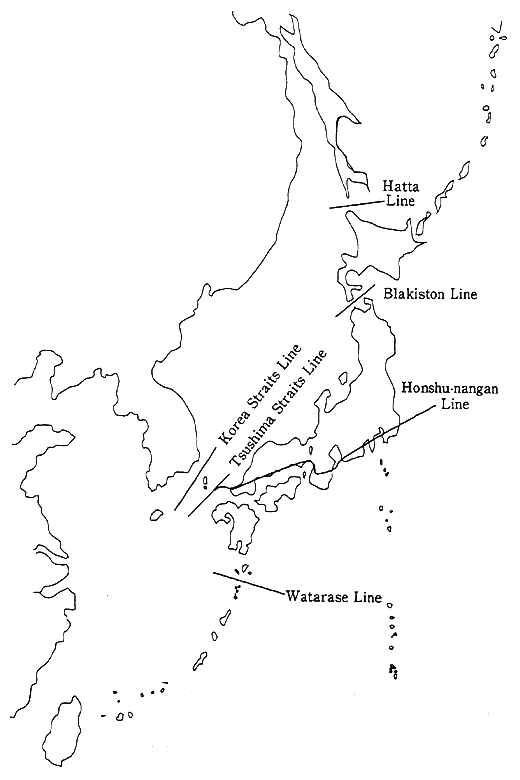
Source : Kawai, 1980
Reference: Third National Survey on the Natural Environment,comprehensive Report
(4) Natural Scenery
Natural phenomena as well as excellent topography and geologi-cal features, as landscape scenes of natural features, such as waterfalls, canyons and mountains, besides being symbols of the regions of Japan in addition form their respective characteristic ecological systems and are priceless locations as places for natural sightseeing, tourism, recrea-tion and learning and, moreover, as places for recovering humanity through being impressed by natural vistas.
According to the Natural Landscape Resource Survey of the 3rd National Survey on the Natural Environment compiled in 1989, there are 15,468 natural landscape resources in Japan. The most numerous are waterfalls (2,488). The following, in order, are ravines and canyons (996), non-volcanic single mountain peaks (993), lakes and marshes (872), cliffs eroded by the sea (734) and sand beaches and shores (632). These seven resources comprise about one half of the total. The present state of the protection of natural scenery is that close to half are in some kind of protective system, such as a national park, with 23% of the total distributed in national parks and 15% in quasi-national parks (Figure 5-5-7).
Fig. 5-5-5 Breakdown of Vegetation by Data on Animal Habitats
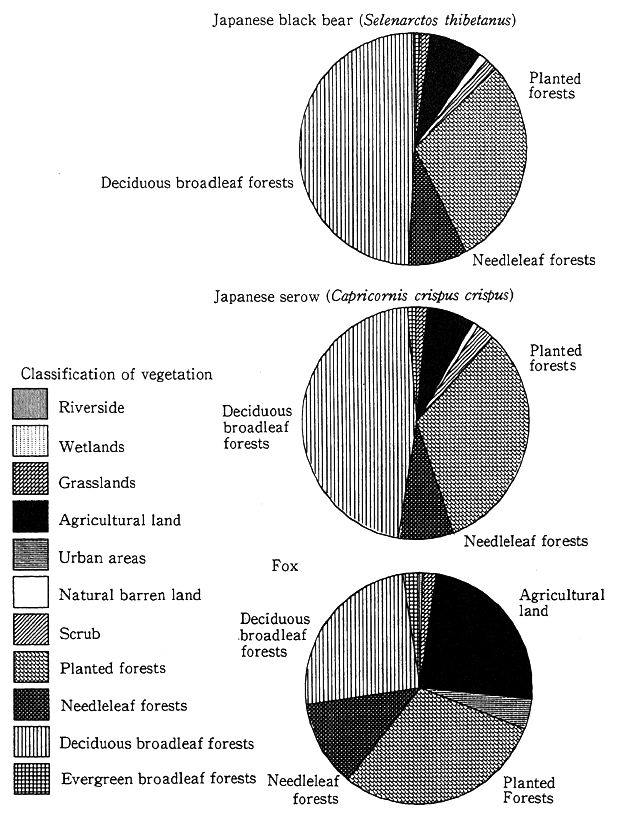
Note : The analysis was conducted by mesh units. Therefore, it is necessary to interpret the statement "the various species' habitats were easily verified because of the various types of vegetation in most of the areas observed." For example, it is necessary to interpret "habitats were verified in agricultural land" as meaning "habitats were easily verified in most of the agricultural land observed."
Source : Third National Survey on the Natural Environment, Comprehensive Report
Fig. 5-5-6 Distribution of Butterfly Varieties and Temperature Indices
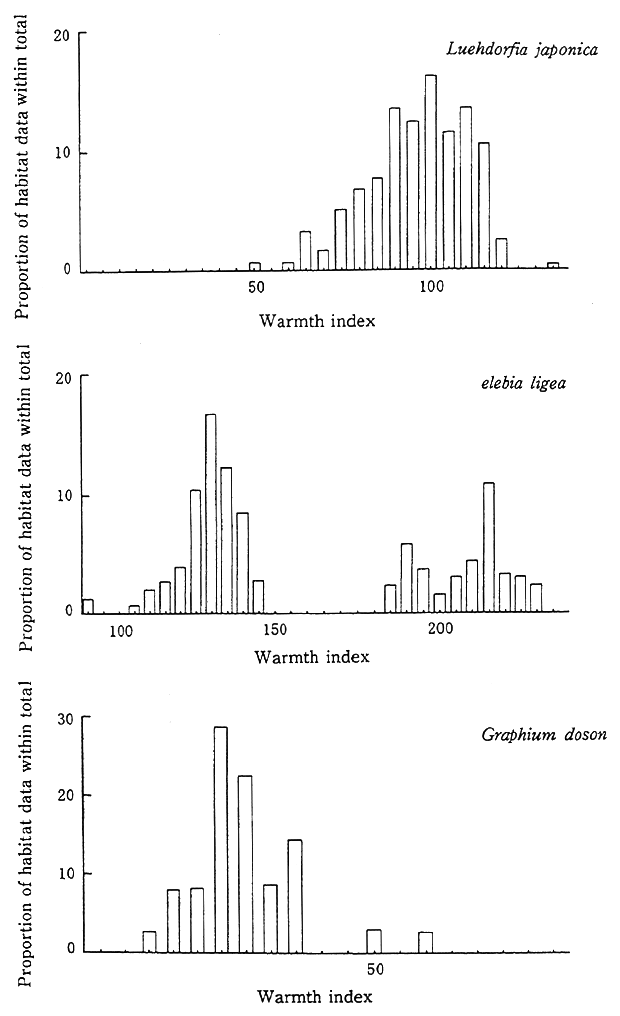
Source : Third National Survey on the Natural Environment, Com-prehensive Report
Fig. 5-5-7 The Preservation of Natural Scenery(total natural scenic resources)
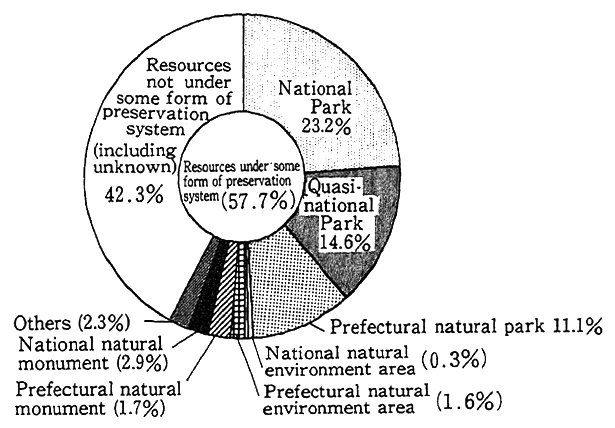
Source : Third National Survey on the Natural Environment, Natural Scenic Resources Survey
Under the World Heritage Convention natural regions that have notable universal value from the viewpoint of conservation, science and enjoyment are registered as world natural assets, as humanity's com-mon assets, and measures are adopted so that their good natural condition will be sufficiently protected. In Japan in December 1993, beginning with the group of large Yaku cedar trees that are represented by Jomon cedar, on Yaku Island of Kagoshima Prefectur that boasts characteristic flora and the Shirakami mountain region spread across Aomori Prefecture and Akita Prefecture that has primeval virgin Japanese beech forests where scarce birds live, were first registered as world heritage. Besides these, as of January 1995, 114 regions have been registered as world natural heritage, such as Yellowstone National Park in the United States, the Great Barrier Reef in Australia and the Galapagos Islands in Ecuador.
2. Ecosystems by Region
(1) Mountains
Mountain areas are mostly covered with forests and, in addition to providing the habitat where wild animals live, are places that provide with various resources. When the relationship between the degree of forest cover and the degree of slope is shown in Figure 5-5-8 it can be seen that as the average degree of slope becomes greater the percentage occupied by forest area becomes greater and at a degree of slope that exceeds 30 degrees almost all are covered by forest. This kind of mountain area forest plays an important role in preventing damage, such as the flow of dirt and sand. There are also not a few man-made forests among mountain area forests and as the slope becomes greater their percentage also tends to decrease, but that recently the hand of man has reached rather deep into the mountains can be understood from the fact that even in areas of steep slopes of 30 degrees or more the percentage of man-made forests exceeds 14%.
Fig. 5-5-8 Distribution of Forests by Degree of Incline

Prepared by the Environment Agency based on the National Land Agency's data
Mountain areas, also, for a long time have played an important role in our national life, such as being the symbols of areas and the objects of religious faith. In addition, they also play a role as places for recreation and sightseeing. In the natural landscape survey, among those that were often seen as natural landscapes, the top three, which are waterfalls, volcanoes and ravines and canyons, are each natural landscapes that can be seen in mountain areas.
Recently the population in the mountains has been decreasing and, beginning with the management of man-made forests that are endowed with the work of many people, the use and management of the mountain environment are declining and the relationship between the natural environment of mountain areas and their use seems to be rapidly changing.
(2) Lakes and marshes
In Japan, including the lakes and marshes in the mountain areas, there are many lakes and marshes, such as those that exist near the coast and on the plains, like lakes that are remnants of the ocean created when the ocean receded. The Environment Agency carried out in 1991 the Lake and Marsh Survey of the 4th National Survey on the Natural Environment targeting; in principle, the 480 lakes and marshes that cover one ha or more, among the natural lakes and marshes. When the situation of the alteration of the lake shore in this survey is looked at, compared to the results of the 3rd survey, natural lake shore has decreased and most of the lake shoreline has become man-made. The ground where the natural land has been conserved is 57% and where it has been altered in some way by man is 43%.
During the 46 years from 1945 until the time of the 4th survey reclamation by drainage and filling in has been carried out at 66 lakes and marshes, about 347 km2 and the total value of the drained and filled in area is equivalent to about 15% of the total area of the lakes and marshes that were subject to aggregation and analysis. Of the total amount of this reclamation by drainage and filling in 98.5% was carried out in the 34 years after the war from 1945 until the 2nd survey was conducted in 1979. In this work four lakes and marshes were completely eliminated by draining.
According to a survey of the types of fish living in 60 lakes and marshes that were specially designated lakes and marshes, there were about 25 species, on average, per one lake and marsh. Of the principle imported species of fish it was confirmed that rainbow trout, Ctenopharhyngodon idellus and black bass, etc. inhabit about one-third of the specially designated lakes and marshes. Because these kinds of import-ed species are taking hold in lakes and marshes in every area they are an important factor causing the fauna of lakes and marshes to change and it is necessary to pay attention to their changes.
(3) Rivers and streams
Concerning the natural environment of rivers, the Environment Agency conducted the 2nd and 3rd River Surveys on the National Surveys on the Natural Environment in 1979 and 1985 targeting the main rivers among the first class rivers in the nation. Of the 11,412.0 km of river bank that was targeted, the river bank at the time of the usual amount of water that abuts man-made structures, such as a river wall, was 2,441.5 km nationwide, 21.4% of the length of all the rivers. When compared to the 2nd survey the length of man-made river bank nation-wide was 249.3 km and the proportion it comprised had increased 2.2% (Figure 5-5-9).
Fig. 5-5-9 Status of Riverbanks Nationwide
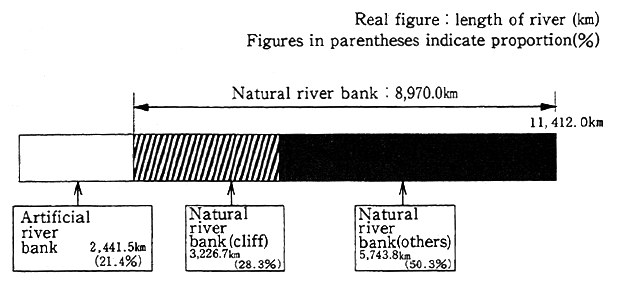
Note : Data are as of 1985. Changes in the river banks are indicated by the average distance between the right and left side of the banks. Artificial river banks refers to those that during periods of normal flows abut protective enmbankments or other artifi-cial structures.
Source : Third National Survey on the Natural Environment, River Survey conducted in 1985
One of the major objectives in this survey was to grasp the relationship between the river's fauna and the increasingly man-made nature of the river banks by surveying the condition of the alteration of the river banks. When the land use of the river bank is looked at, 33.3% of the total river area is natural, 7.6% is agricultural land, 0.8% is unused reclaimed land and 2.6% is used for facilities. When the changes in the river beach, classified by land use, are looked at nationwide, there are trends towards a decrease of natural land and an increase in agricultural land as well as land used for facilities.
As for river crossing works, such as dams and weirs, because if appropriate measures are not devised to help fish go upstream the living areas of fish are divided into sections, the Environment Agency sur-veyed the river crossing works in the 1985 river survey in order to grasp the living conditions of fish. Of 11.3 rivers surveyed 13 rivers had no river crossing works or rivers with crossing works with fish ladders that worked well and enabled fish that go upstream (salmon, Oncorhynchus masou masou, sweetfish, etc.) to go upstream to the end of the surveyed section (Table 5-5-3). Further, between the 2nd survey and the 3rd survey, there were two rivers, the Shimanto River and the Shirakawa River, on which it became impossible for fish to go upstream due to the installation of river crossing works in the upper and middle flow regions.
Table 5-5-3 Rivers in which Fish can swim Upstream
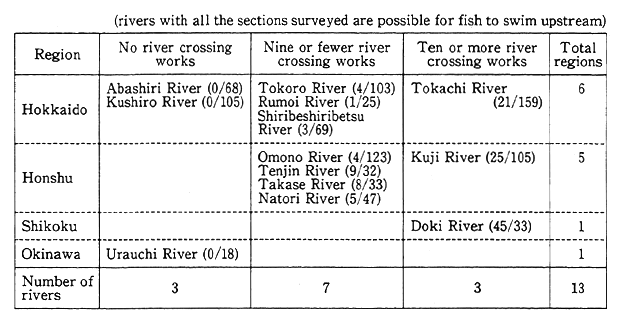
Note : Figures in parentheses are the number of river crossing works/number of sections surveyed
Source : Environment Agency, Third National Survey of the Natural Environment, River Survey (conducted in 1985)
The river bed and flow conditions of Japan's rivers are unstable, because there is much rain, the topographical conditions are those of steep inclines and there are frequent floods. Further, recently the demand for water has increased along with the improvement in the standard of living, and besides constructing, on the upper parts of rivers, multipurpose dams, etc. river crossing works for the purposes of irrigation and .flood control, the construction of weirs, etc. on the middle and lower parts of rivers is being implemented. For example, various disputes have arisen concerning the influence exerted on the natural environment, e.g. the going upstream of fish is blocked by the weir at the mouth of the Nagara River, but the implementing of an environmental survey and complete conservation of the environment is expected. From now on concerning the installation of river crossing works, the implementation of sufficient investigation of their influence related to the ecological system of fish, etc. is necessary.
When the living conditions of fish classified by river are looked at, the rivers with the most fish are almost all in Honshu (Table 5-5-4), further, few types of fish are living in short rivers, rivers with fast flows as well as in the Hokkaido area separated by the Blakiston line related to fauna.
Table 5-5-4 Rivers Inhabited by Many Fish Species
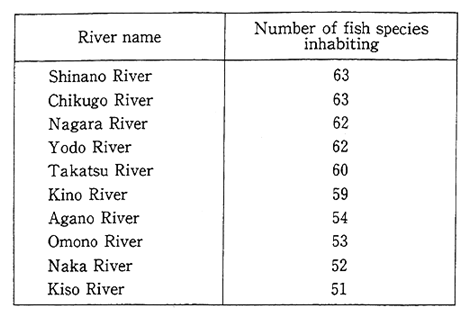
Note : The inhabiting species were actually confirmed or were reported.
Source : Environment Agency, Third National Survey on. the Natural Environment, River Survey (conducted in 1985)
The Ministry of Construction has been implementing since 1990 the national survey on the condition of the area around rivers that surveys the living conditions of organisms living in rivers. In the 1993 survey, concerning the survey of fish, there were 240 species in 43 water systems, concerning the survey of birds, it was confirmed that there were 233 species in 32 water systems.
(4) Wetlands and tidelands
Wetlands and tidelands compose unique ecological systems in the natural environment and are important as the habitats of water birds and aquatic life. Wetlands have much water compared to the ordinary ground surface and form the habitat in which the unique animals and plants that like this kind of environment live becoming a splendid habitat for aquatic life and water birds. In the Convention on Wetlands of International Importance Especially as Waterfowl Habitat (Ramsar Convention) wetlands are comprehended by a broad concept that includes wetlands, rivers, swamps and tidelands, etc. The number of wetlands that Japan has registered at present are the nine places of Kushiro Swamp, Kuccharo Lake, Utonai Lake, Kiritappu Swamp, Akkeshi Lake, and Betsukanbeushi Swamp in Hokkaido, Izu Marsh and Uchi Marsh in Miyagi Prefecture, Yatsuhigata in Chiba Prefecture, Katano-kamoike Lake in Ishikawa Prefecture and Biwa Lake in Shiga Prefecture.
Tidelands are important as the living environment of organisms that are unique marine life and water birds. Because most tidelands are in the inland sea in which, generally, pollution progresses easily and cleanup progresses with difficulty, the water purification ability of tidelands is also attracting attention. According to a survey conducted by the Environment Agency from 1988 to 1991, there are at present 51,462 ha of tidelands and 40% of the nation's tidelands are distributed in Ariake Sea in Kumamoto Prefecture (Table 5-5-5). Further, it has become clear that 4,076 ha of tidelands have disappeared since 1978 due to such reasons as subsidence and land fill (Table 5-5-6).
Table 5-5-5 Area of Tideland Classified by Sea Area

Note : The "percentage" is with respect to the area of tideland in the entire country.
Source : Environment Agency
Concerning the conservation of tidelands, in addition to conservation under the Natural Parks Law and the Wildlife Protection and Hunting Law, besides the preservation of tidelands proceeding based on the Basic Plan for the Conservation of the Environment of the Seto Inland Sea, by means of the Law Concerning Special Measures for Conservation of the Environment of the Seto Inland Sea, comprehensive measures are proceeding, such as consideration of environmental conservation concerning landfill, conservation of the natural beach and prevention of the occurrence of damage due to eutrophication.
(5) Shorelines
Shorelines that have maintained their natural condition are not just important as places where organisms breed and live, they have often formed excellent scenic attractions that for a long time have been used and appreciated as places for recreation. The artificial transformation of the coastline during the period of high ecomomic growth rapidly proceeded along with urbanization and industrial development.
Table 5-5-6 Reasons for Disappearance of Tideland (including multiple reasons)
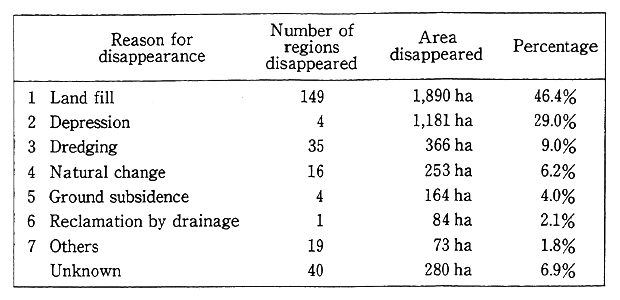
Note : The "percentage" is with respect to the area of tideland that has disappeared in the entire country.
The "natural change" means the outflow of sand and beach erosion, etc.
Source : Environment Agency
According to the Coast Survey of the 4th National Survey on the Natural Environment conducted in 1993, the total length of Japan's shoreline is 32,817 km (an increase of about 345 km in comparison with last survey in 1984) and the mainland portion was 19,134 km (58.3%, an increase of 214 km), the island portion was 13,684 km (41.7%, an increase of 131 km). When the nationwide percentage of the coastline is looked at, natural coastline comprises about half at 55.2 %, next man-made coastline comprises 30.4%, but when compared with the previous survey, the natural coastline had decreased 293 km. When only the mainland portion is looked at, the natural coast is 44.7% and the man-made coast comprises over one-third at 38.0% (Figure 5-5-10).
(6) Areas on the periphery of cities
The green areas and waterfronts that close to daily lives are on a small scale and are apt to be overlooked, but in addition to being the living environments for organisms as one important part of the natural environment of the country, for people, also, they are precious as places for recreation and as landscapes. These kinds of urban areas, besides helping to improve the environment and climatic conditions of an urban area, such as by easing the heat island phenomenon, have the roles of reflecting the condition of the soil as well as the quality of water and air of the city itself.
Fig. 5-5-10 Proportional Classification of Coastlines
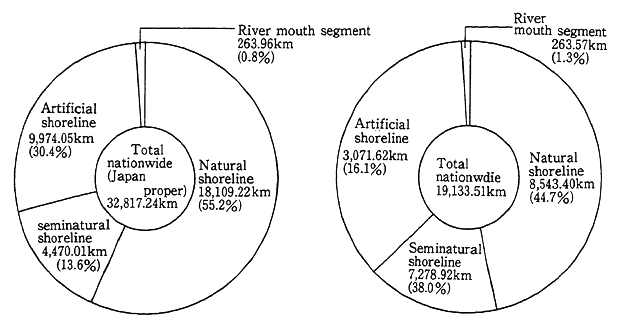
Notes:1. Applies to shorelines nationwide including minor islands with a radius of 100 meters or more (excluding the North-em Territories).
2. Japan proper refers to Hokkaido, Honshu, Shikoku and Kyushu.
3. The classification of coastline is as follows: Natural coastline: shoreline without any man-made structures Seminatural coastline; no man-made structures within the tide line (the strip of shore between high tide and low tide), however, man-made structures may exist in the back shore (that land behind the tide line that still receives the effcets of the waves) Artificial coastline: coastline with man-made structures within the tide line
Source : Environment Agency, Fourth National Survey on the Natu-ral Environment, Beach Survey
The fundamental survey of the conservation of the natural envi-ronment is carried out by classifying vegetation by the degree to which it is influenced by people's actions, but when these five divisions are compiled as natural vegetation, secondary forests, afforested forest, agricultural land and urban land and the natural conditions of the metropolitan areas (Tokyo, Kanagawa Prefecture, Saitama Prefecture, Chiba Prefecture), Aichi Prefecture and Osaka Prefecture are analyzed, in each of these areas natural vegetation is extremely scarce compared to the national average (Figure 5-5-11). Further, in city neighborhoods secondary vegetation, the so-called familiar habitat of natural and wild vegetation as a mountain village, are being created, but this kind of vegetation is also, generally, scarce.
Fig. 5-5-11 Vegetation in Three Urban Areas
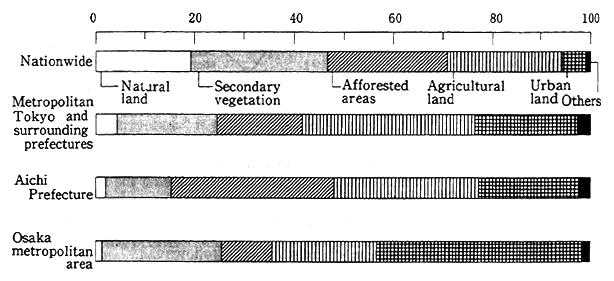
Note: Survey conducted between 1983 and 1986
Source: Environment Agency, Third National Survey on the Natural Environment, Vegetation Survey
The ground surface that goes along, with urbanization is covered with artificial products, such as concrete. Further, due to the spread of air conditioning and the increase in the discharge of heat, the heat island and drying processes are occurring. Consequently, due to the local changes in the climate, an influence on the ecological system is appear-ing. For example, the spontaneous generation of hemp palms that originally lived in a warm region have been seen in Tokyo. The influence of drying can be seen in the phenomenon of a decline in Japanese cedar trees on the grounds of the farm house and in the woods of shrines and temples.
Meanwhile, change in fauna by advancing from the surrounding regions to the metropolitan areas is also a situation that is progressing and there are even examples of martins and Motacilict alba that lived in the mountains adapting themselves to the urban environment recently and expanding their habitat.
(7) Agricultural and mountain villages
Agriculture is the activity of cultivating crops by adding human actions to the natural ecological system and gathering things that are useful to us and it has various influences on the natural environment. Agricultural chemicals and chemical fertilizer are materials that are necessary to the agricultural industry, but an excess of them can lead to causing the burden on the environment to increase.
Meanwhile, agriculture that has been conducted for a long time forms a unique ecological system in agricultural areas and the regions that surround them. Wet paddy agriculture that is Japan's typical agriculture through a long tradition has created a unique ecological system composed of irrigation channels, irrigation reservoirs and levees and it has come to be the habitat of the familiar life forms of dragon-flies, fireflies, roaches and frogs.
In the mountains surrounding agricultural and mountain villages are distributed the so-called mountain village forests composed of Japanese red pine, Quercus serrata and Quercus acutissima forests that have come to be used for fuel. The existence of many types of butter-flies, such as "usubashirocho" (Parnassius glacialis) and "gifucho" (Lueh-dorfia japonica) and species of birds, such as brown hawk owls and heron has been confirmed in the environments of these kinds of agricul-tural and mountain villages, and also many cases can be seen of the formation of original ecological systems by the living things that are familiar to us (Figure 5-5-12).
These days, the progress of mechanization, to reduce labor and the decline of the populations of agricultural and mountain villages, will probably greatly change the natural environment of agricultural and mountain villages. Since food, charcoal and brushwood have stopped being used for fuel people have stopped tending the forests of the mountain villages and weeds are beginning to grow luxuriantly under the trees. This can also be viewed as a transition to more natural vegetation, but, on the other hand, some familiar living things are disappearing from the mountain villages.
"Yatsuda" in the middle of rice paddy fields, with an abundant ecological system coupled with the surrounding forest could be easily abandoned from the point of view of making a profit simply because it is deep in the mountains and it can be predicted that its form will change. Further, it can also be predicted that the changes in agriculture from now on will exert a great influence on the natural environments of agricultural and mountain villages. Concerning the conservation of the natural environment of agricultural and mountain villages, besides the designation of natural parks and forest reserve regions, the promotion, of environmental conservation type agriculture that considers lightening the burden on the environment is being carried out.
Fig. 5-5-12 Relation between Vegetation and Species
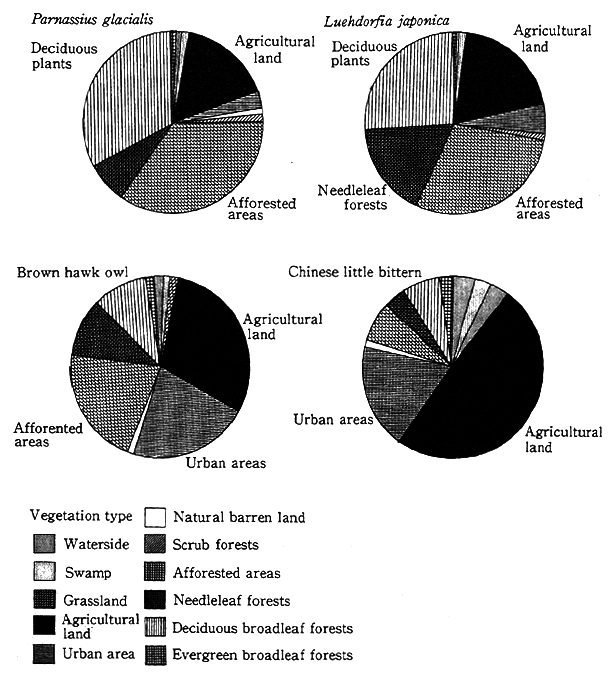
Note: The analysis was carried by mesh units. Therefore, it is necessary to interpret the statement "the various species" habitats were easily verified because of the various types of vegetation in most of the areas observed.
For example, it is necessary to interpret "habitats were verified in agricul-tural land" as meaning "habitats were easily verified in most of the agricultural land observed."
Source: Comprehensive Report, the Third National Survey on the Natural Environment
3. The Status of Natural Ecosystems in the Developing Countries
(1) Forests
Forests occupy about one-third of the world's land area. It has been estimated that as of 1992 there were 3.8798 billion ha of forests.
Recently, concern has grown about the rapid decrease in the forests of the developing countries in tropical regions. As causes of the decrease in tropical forests nontraditional slash-burnt agriculture, excessive collection of wood for fuel, inappropriate tree felling for commerce and overgrazing can be pointed to, but, social and economic factors, such as poverty, population growth and land systems in developing countries, can be mentioned as being behind these direct causes.
Tropical forests play an important role in absorbing carbon dioxide and adjusting the earth's radiation and water balance. They also are endowed with an important function in the conservation of biological diversity. The recent rapid decrease in tropical forests does not just exhaust forest resources, it brings about a decrease in the species of animals that live in them and has caused the fear that the situation is at the stage where recovery is not possible. It has been said that 50-80% of the organisms that exist on the earth live in the tropical forests. With the decrease in tropical forests there is an anxiety that these kinds of animals and plants disappear and habitat is contracted to the point where maintaining species will be difficult.
In the 1990 Forest Resources Evaluation Project made public in 1993 by the United Nations Food and Agriculture Organization (FAO), in contrast to a total area of tropical forest at the end of 1980 of 1.91 billion ha, there had been a decrease of about 8% to 1.756 billion ha ir the ten years to the end of 1990. When the decrease in tropical forests is looked at classified by region, in these ten years about 8% was in central and south America, about 12% was in Asia and the Pacific and about 7% was in Africa (Table 5-5-7).
As for the influence of this kind of decrease in tropical forests, in addition to many wild species being brought to the brink of extinction due to the disappearance of large areas, that global warming caused by the large volume of carbon dioxide emission is being accelerated due to the disappearance of the forests is causing anxiety. A forest is a system of a group of land organisms in which the forest biomass (the present amount of organic matter on the earth) exists that is the source that supplies diverse industries, such as fodder, fuel and lumber and has the greatest ability to fix carbon in wood fiber and in the leaves of the forest crown. Further, it is said that about 50% of the forest biomass is carbon and this is also useful information when comparing and verifying the structural and functional characteristics of the forest ecological system under diverse environmental conditions.
Table 5-5-7 Area of Forest Cover and Estimated Loss of Forest Area and Deforestation by Region
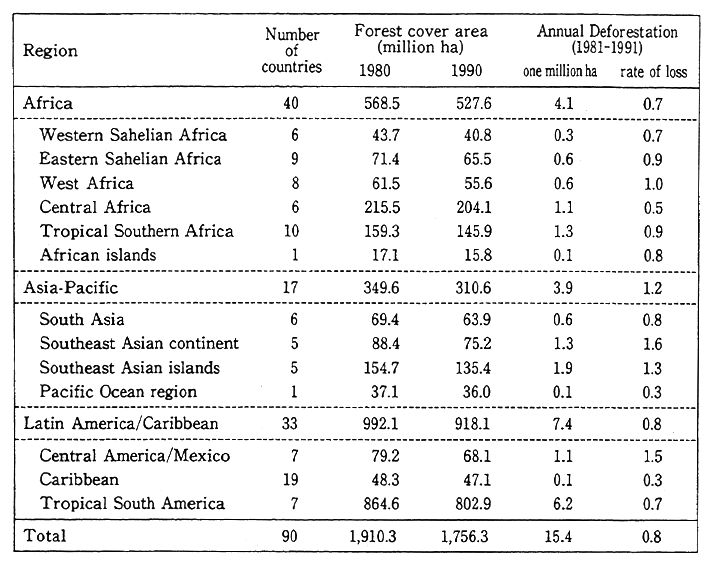
Source: FAO Final Report on the 1990 Forest Resource Evaluation Project (1993)
According to the above mentioned report of the FAO, in contrast to the high value shown in the amount of forest biomass per one ha in the areas of the Caribbean Sea, Central Africa and the islands of southeast Asia, in tropical southern Africa and the African Sahel the value is extremely low. Further, because of high population pressure, in southern Asia the biomass per person is remarkably low.
With respect to the decrease in the forests, particularly the decrease in tropical forests, cooperation by international organizations, such as the International Tropical Timber Organization (ITTO) and the FAO and bilateral cooperation between countries is proceeding. Fur-ther, in January 1994, the new International Tropical Timber Agree-ment was adopted containing the so-called year 2000 objective with the principle of "increasing the ability of member countries to implement a strategy in order to achieve by the year 2000 the carrying out of the exportation of tropical timber products and tropical timber mainly from supply sources that are managed in a sustainable way."
(2) Soils
Soil is the foundation of the agricultural and livestock industries. The depletion and loss of soil not only makes these activities impossible, but also influences people's very lives. Modes of soil depletion are, erosion due to flow loss from falling rain, erosion due to wind blowing away the topsoil, salt accumulation and alkalinization and filling up with water. The so-called desertification problem of the loss and deteri-oration of soil has two causes. There is the climatic cause of the moving of the arid area due to changes in the circulation of the atmosphere on a global scale. And there is the human cause that is the activity of people exceeds the acceptable limits in the fragile ecological systems of semi-arid and arid regions. For example, in the Sahel region of Africa grazing and collecting wood for fuel that exceeds the regenerative capacity of grass and trees and migratory farming with short cycles are frequently seen. For this reason the deterioration and loss of soil is easily brought about and once a drought occurs people flow out to other land areas or cities as environmental refugees.
According to the Report on the Status of Desertification and Implementation of the United Nations Plan of Action to Combat Desertification that the UNEP made public in 1991, there are over 6.1 billion ha of arid land in the world and they comprise close to 40% of the earth's land. About one-fifth of the world's population lives in this arid region. Of it 900 million ha is an extremely arid region, the so-called desert, and in part of the remaining 5.2 billion ha desertification is proceeding due to human activities.
Further, the region exposed by soil deterioration is 1.1373 billion ha and comprises 18% of the total arid area, with the extremely arid regions included. When looked at classified by continent, Asia has the most extensively damaged area, next come Africa and Europe, but when the percentage of arid land surface that is comprised of deteriorat-ed soil is looked at, Africa at 81% has an especially large amount.
In order to cope with this desertification problem internationally, from May 1993 governmental negotiation was started to conclude an international treaty to prevent desertification and in June 1994 the United Nations Convention to Combat Desertification in Those Countries Experiencing Serious Drought and/or Desertification, Particularly in Africa was adopted. Further, in October of the same year at the treaty signing ceremony 86 countries (including the EU), including Japan, signed. Japan, besides being actively involved in the adoption of the treaty up to now, has been also carrying out measures from the viewpoint of supporting arid area agriculture and afforestation and elucidating the mechanism of desertification. From now on also, in addition to strengthening measures concerning the desertification problem to collaboratively cope with international trends such as those mentioned above, multirateral and bilateral cooperation in preventing desertification is called for.
Section6. The Status of the Diversity of Wildlife
1. Current State of Wildlife
(1) Endangered species in Japan
Japan, reflecting its diverse climate and topography as well as geographical location, is blessed with a natural environment that is abundant with variation and its wildlife, also, has become diverse because of these kinds of breeding and living conditions. Wildlife species are precious information sources by their very existence and as essential elements composing the ecological system they are responsible for the flow of energy and the circulation of matter and the balance of the ecological system is maintained by their diversity.
Further, humanity has come to coexist with wildlife species beginning by using them as their daily food and by using them for art, recreation, education and science and as materials for various tools. However, this kind of activity is sometimes connected to indiscriminate fishing and hunting and, due to the destruction of habitat that accom-panies the expansion of human economic and social activity, wildlife species are decreasing and are continuing to face pressure that leads to a reduction in their number and extinction. Once species of life is lost human acts can't bring recreate it. The prevention of the extinction of wildlife species, whether viewed from the perspective of conservation of the ecological system, or viewed from the perspective of protecting the various values that wildlife possess, has become an urgent task.
In order to. cope with this kind of problem, on 1 April 1993 the Law for the Conservation of Endangered Species of Wild Fauna and Flora was implemented as a system designed to conserve wild fauna and flora that are in danger of extinction in areas inside of and outside of the country. Based on this law, concerning the species that live in Japan that are in danger of extinction, countermeasures have been devised to, gradually, designate them as rare domestic species of fauna and flora, regulate their capture as well as transfer, protect their habitats and increase protection operations. And, in February 1995, to the 44 species that were already designated, the four species of Opisthotropis kikuzatoi, Hynobius abei Sato, 1934, Acheilognathus longipinnis, Polemonium kiushianum Kitam, were added.
1) Animal species
The Environment Agency, in order to select the species of fauna and flora native to Japan that are in danger of extinction, conducted the Survey on Fauna and Flora Species Urgently Requiring Protection and, based on the 1991 survey results, issued the Endangered Wildlife in Japan (Red Data Book) concerning animals. The number of species including sub-species of wildlife native to Japan that were subject to this survey was 1,199 species of vertebrates and 33,776 species of inverte-brates (Table 5-6-1).
Of these species, three categories are introduced according to the state of the danger to their continued existence:1) "endangered species," which are on the brink of extinction; 2) "vulnerable species," which if the present situation continues will be on the brink of extinction in the near future; 3) "rare species," which, depending on changes in living conditions,. may easily become "vulnerable species," or "endan-gered species."
There are 110 endangered species, 114 vulnerable species and 415 rare species, in addition 22 species have been confirmed to be extinct (Table 5-6-2).
As reasons for these wildlife species becoming extinct or being in danger of extinction, worsening of the water quality, changes in vegeta-tion, indiscriminate hunting or fishing and other extinction and aggrava-tion of living environments by people, have been pointed out and the living environments of Japan's wildlife have come to be in a severe situation.
Table 5-6-1 Number and Species of Wildlife that are in Danger of Extinction in Japan
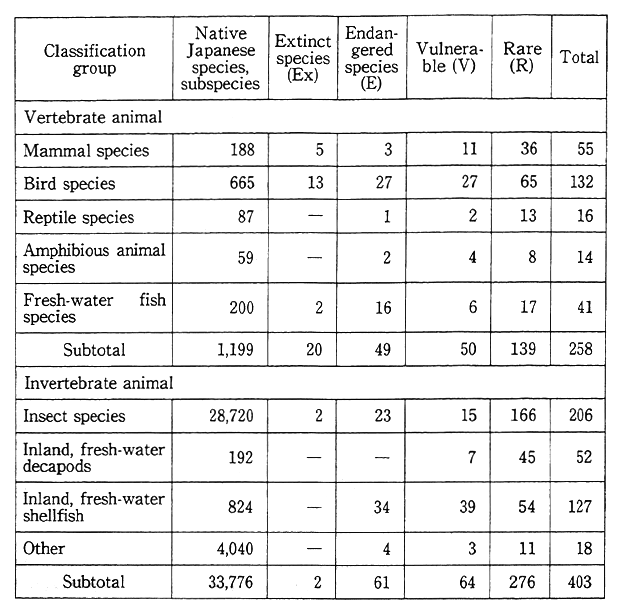
Note: The figures include species and subspecies.
The numbers of native Japanese species and subspecies are the numbers for those that have been given scientific names.
Extinct: Species and subspecies that can be regarded to have already been extinct in Japan
Endangered: Species and Subspecies that are on the brink of extinction
Vulnerable: Species and subspecies for which the danger of extinction is increasing
Rare: Species and subspecies which have a fragile basis of existence
Source: Enviromnent Agency, Survey on Fauna and Flora Species Urgently Requiring Protection
Of the animals and plants that are in danger of extinction there is the example that in 1952 it was confirmed that only 33 Japanese cranes were alive in Hokkaido, but as a result of protection and propagation activities, in January 1995 it was confirmed that 607 were alive. As for the albatross that once was regarded as having become extinct, at present about 600 have been confirmed living on Torishirna Island, and protection and propagation measures are being implemented, such as by using decoys and forming a safe new breeding ground. Further, with respect to the Blakiston's fish owls that have been confirmed as living in the eastern and central parts of Hokkaido, as a part of protection and propagation operations, taking eggs and incubating them artificially was tried and succeeded for the first time in the world.
Table 5-6-2 Extinct Species and Endangered Species in Japan Listed in the Red Data Book
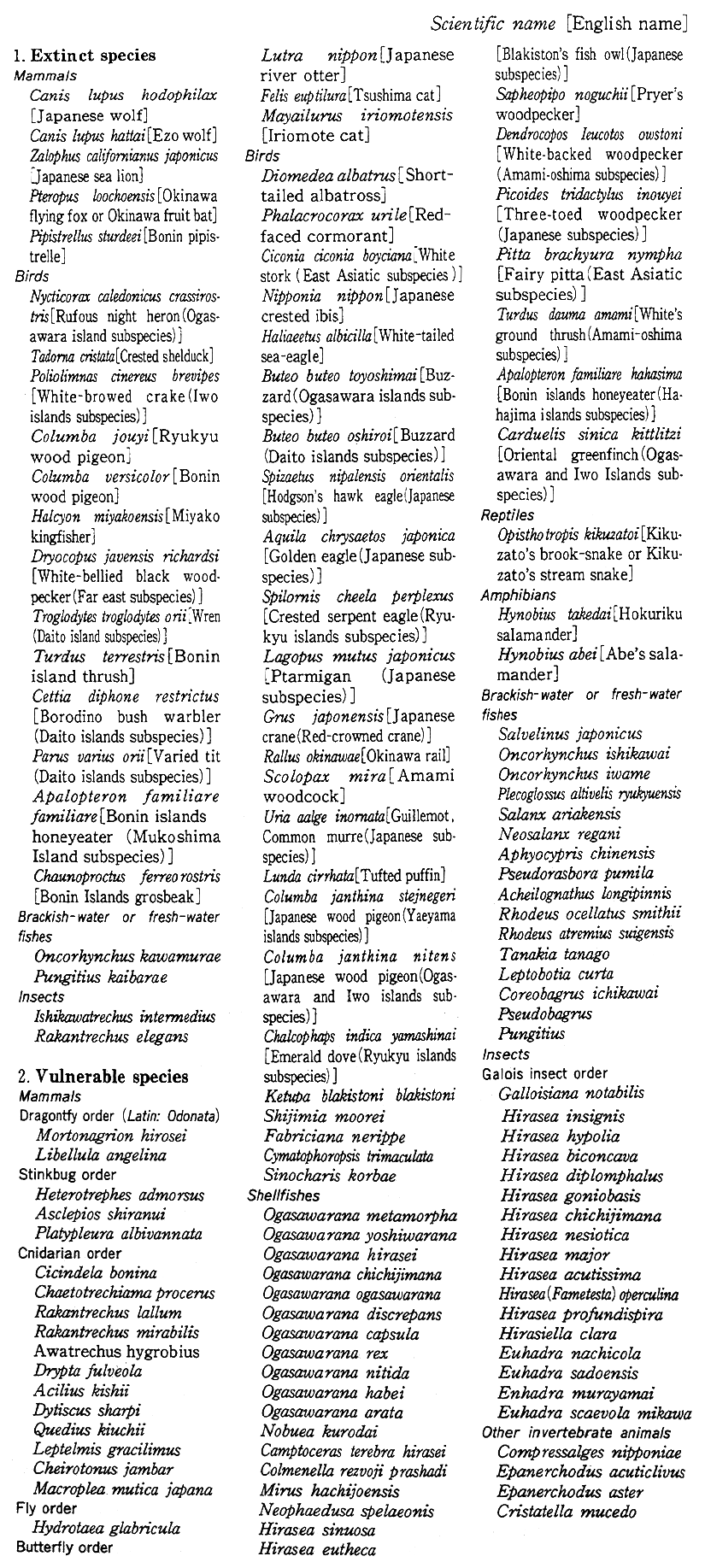
2) Plant species
As for the plants that live in Japan, according to the Environment Agency's Survey on Fauna and Flora Species Urgently Requiring Protection, 8,118 species of vascular plants, 1,850 species of seaweed, 1,516 species of thistles, 535 species of moss, 2,295 species of lichen and about 10,000 species of fungus (including subspecies, hybrid species, breeds and sub-breeds) were confirmed. According to the report titled Present Situation of Plant Species Important to Protection in Japan prepared by the Nature Conservation Society of Japan and the World Wildlife Fund, Japan, as for the plant species that are in danger of extinction (including subspecies and hybrids), there are 147 species on the verge of extinction, 677 species that are in danger of extinction, 36 species that are in danger but whose actual situations are unclear and 35 species that are extinct (Table 5-6-3).
Table 5-6-3 Number of Plant Species that are in Danger of Extinction
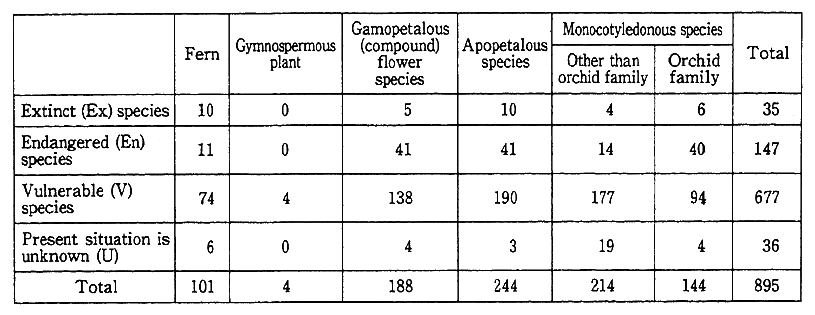
Source: "Present Situation of Plant Species Important to Protection in Japan" (1989) edited by Species Subcommittee of the Study Committee on Plant Species and Communities in Japan to Protect, and published by Japan Nature Conservation Society, World Wildlife Fund, Japan
The reasons why this many species were on the verge of extinction were pointed out to be the deterioration of the living environment that goes along with development, the extinction of habitat as well as indiscriminate hunting by enthusiasts. Particularly, the destruction of the living environment is not limited to physical destruction, the environment that surrounds the habitat, that is, not paying sufficient atten-tion to the ecological system, also, is becoming a problem.
(2) The status of wildlife in Japan
It has been confirmed that, as for animals, there are 188 mammal species (including subspecies, the same for the following), 665 bird species, 87 reptile species, 59 amphibian species, 200 freshwater fish species, 28,720 insect species, 192 spiders and decapods species, 824 species of inland or freshwater shellfish, 4,040 species of other invertebrates and, as for plants, 8,118 species of vascular plants, (including subspecies, hybrid species, breeds, sub-breeds), 1,850 species of seaweed, 1,516 species of thistles, 535 species of moss , 2,295 species of lichen and about 10,000 species of fungus existing in Japan.
These numbers are not very large when compared to countries with "mega diversity" that have many wildlife species, but when compared to advanced countries, especially the European countries, the wildlife species are abundant. This can be regarded as being the fact that due to Japan's climatic, geographic and topological conditions its diverse ecological systems exist spread from the sub-tropical to the sub-Arctic, in contrast in Europe the ecological systems of the abundant forests, etc. are few due to the development of agriculture.
For example, as for the plant composition of Japan's forests, when only the higher forms of plants are looked at, of the estimated 250,000 of the world's species (not including subspecies or below), Japan's higher flora is composed of 5,565 species (of them 1,950 species are native species of Japan) That the flora of Japan is abundantly diverse is understood when regions with the same amount of area at about the same latitude are stipulated and their higher flora are looked at. There are 2,835 species in the northeast of the United States and 1,871 species in New Zealand.
Japan occupies an important position as a destination for migra-tory birds from Siberia, etc. More than 60% (including birds that move within the country) of the bird species that are able to be seen in Japan are migratory birds. The species that live in Japan move across the borders of countries and teach us that there are no national boundary in the natural environment. Further, among migratory birds, as with the eagle owl, there are species that have had breeding grounds in Japan recently confirmed (Figure 5-6-1).
Concerning migratory birds, because clarification of their migra-tory routes contributes to international cooperation in conserving the places they visit and in protecting the migratory birds, follow-up sur-veys of migration routes using banding surveys and satellites are being conducted. As a result many migratory routes are being clarified and are contributing to international surveys and research.
The brown bear and the black bear are spieces of bear that live in Japan, but due to the recent rapid changes in the natural environment great changes are appearing in their habitats. The black bear is the largest mammal species that lives on Honshu and represents the wildlife of the forest ecological system from the temperate zone to the low temperature zone. But there is anxiety about its regional extinction and appropriate conservation management inside and outside of the country is called for and the Washington Convention, also, has prohibited trade of it.
In the survey of the actual living conditions of bears conducted by the Environment Agency, due to the influence of the recent development of farm land, residential land and forests, the habitat has been divided into sections due to regions where the living environment was worsened or areas where the continuity of the forest has been lost, and the living conditions have become worse. Figure 5-6-2 shows the changes in the habitat of black bears in the Tanzawa Mountain area and it can be seen that the habitat has been divided into sections by the construction of a road.
Fig. 5-6-2 Areas Inhabited by the Asian Black Bear in the Tanzawa and Dai-Bosatsu Mountain Regions along with Bouiidaries of Cities and Townships
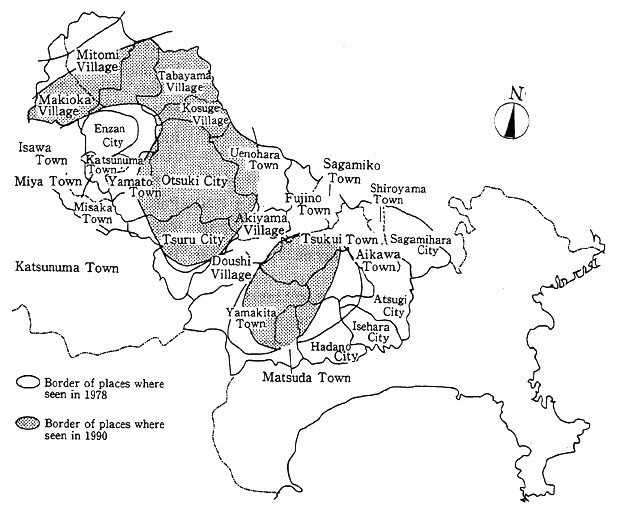
Source: Environment Agency
(3) The status of wildlife habitats overseas
As for the number of wild animal and plant species, research concerning vascular plants and vertebrate animals is comparatively advanced, but concerning invertebrate animals, also including insects, much is not known and an accurate total number of species existing on the earth has not been grasped. Almost 1.4 million species have been confirmed at present, but it has also been said that there are an esti-mated five million or even 50 million species. It has been said that over half of all species live in the tropical forests that only occupy 7% of the earth's land surface area and the number of species of life living in Zaire, Indonesia and South American countries that possess tropical forests is extremely large (Table 5-6-4).
Table 5-6-4 Top Ten Countries with Rare Species
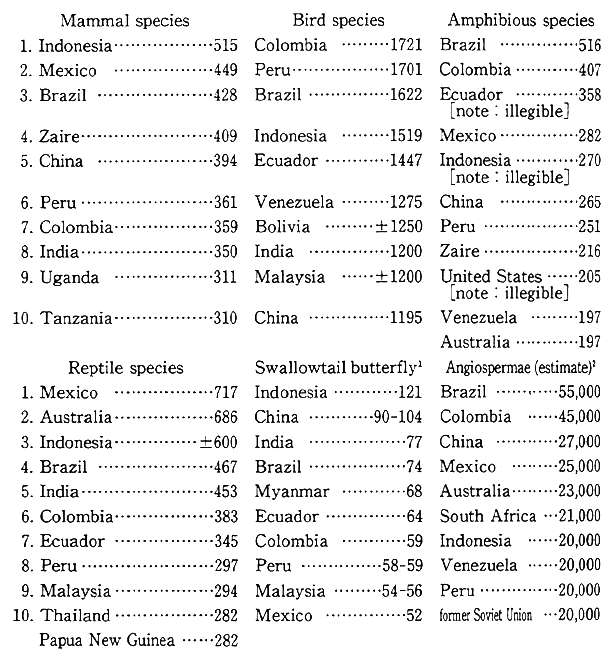
Notes: 1. Collins and Morris, 1985
2. Davis et al., 1986
Reference: "Protect the Diversity of the World's Wildlife" IUCN, WRI, Conservation International, WWF-US, World Bank
Source: Conservation International and others
Countries with so many species of life and native species are called "mega diversity countries." For example, this can be regarded as applying to such countries as Brazil, Colombia, Ecuador, Peru, Mexico, Zaire, Madagascar, Australia, China, India, Indonesia and Malaysia. From 60% to 70% of the world's species of life can be seen in these countries. There are countries which have many species because they have large land areas like Brazil and China, but there are also countries that, while having small land areas like Ecuador, Madagascar and Malaysia, have a high degree of diversity of species due to topological reasons, and countries like Australia and Madagascar that have many native species.
However, even with such abundant biota, due to the destruction of their living and growing areas they are rapidly being lost and there is even a preliminary estimate that if the destruction of the forests continues at the present rate 4.8% of the species that live in the closed forests of tropical forests will become extinct within the next 25 years.
The extinction of species has occurred unceasingly in the past in the process of the advance of the natural world, but in contrast to the past extremely moderate speed, the extinction of species today is not due to natural processes, but to human activities, and moreover, is proceeding at a speed that has never been seen before in the history of the world.
With respect to this trend the extinction of species can be regarded as one of the global environmental problems. The Convention on International Trade in Endangered Species of Wild Fauna and Flora (Washington Convention, CITES) and the Convention on Biological Diversity have been concluded and international measures are being advanced. Further, besides concluding migratory bird protection agreements between Japan and the United States, Australia, China and Russia to promote the protection of such migratory birds as the crane, snipe and plover, Japan and China are cooperating bilaterally in an attempt to breed and propagate the Japanese crested ibis and measures to preserve species in both countries, such as to preserve habitat in China, are being taken.
2. The Status of Wildlife Resources
(1) Marine resources
Japan traditionally has made use of aquatic products as an important source of protein. The amount of aquatic products has almost consistently increased after the World War II and in 1981, except for the aquaculture industry, the amount of product of the ocean fishing industry exceeded ten million tons and in 1984 it reached 11.5 million tons. However, the amount produced since 1989 has been decreasing and the amount produced in 1993 declined to 7.27 million tons. When the changes in production amounts classified by important fish species are looked at, the amount of sardines and Alaska pollack produced is decreasing (Figure 5-6-3). In the waters surrounding Japan, due to the improvement in the abilities of fishing boats, there has even been an increase in the intensity of fishing, and the condition of the resource, in general, centering on the low fish species, is at a low level and there is anxiety about the resources decreasing from now on, even concerning the sardine resource.
The problems of how to be involved with the fish industry and the protection of wildlife have been discussed at various international conferences. At the 8th meeting of the contracting parties to the Washington Convention a movement was seen to place Atlantic Ocean bluefins in the Annex and to restrict international commercial transactions, but with the conditions to strengthen, from now on, conservation and management measures under the international fishing industry management organization, the proposal was withdrawn. Further, in the United States and Europe protection of the whale has come to symbolize the environmental protection movement and there was an excessive amount of opposition to whaling, but at the Summit the principle of rationally using the marine living resources including whales was confirmed, and in the International Whaling Commission, the capture of minke whales, the reopening of the coastal whaling industry and the establishment of an Antarctic Ocean whale sanctuary are being discussed (Figure 5-6-4). These kinds of marine resources are indispensable to the countries of the world from now on as a source of nutrition and as a source of animal feed and their sustainable use is extremely important. Consequently, it is important that appropriately managed fishing based on scientific data be put into practice.
Further, the problem of the fisheries bycatch of marine mammals, sea birds, sea turtles, etc. has attracted worldwide attention and in the face of the stopping (moratorium) of large-scale drift-net fishing on the high seas decided by the United Nations General Assembly in 1991. Japan suspended operations of large-scale drift-net fishing on the high seas by the end of 1992.
Fig. 5-6-3 Trends in Harvest Volume of Major Varieties of Fish
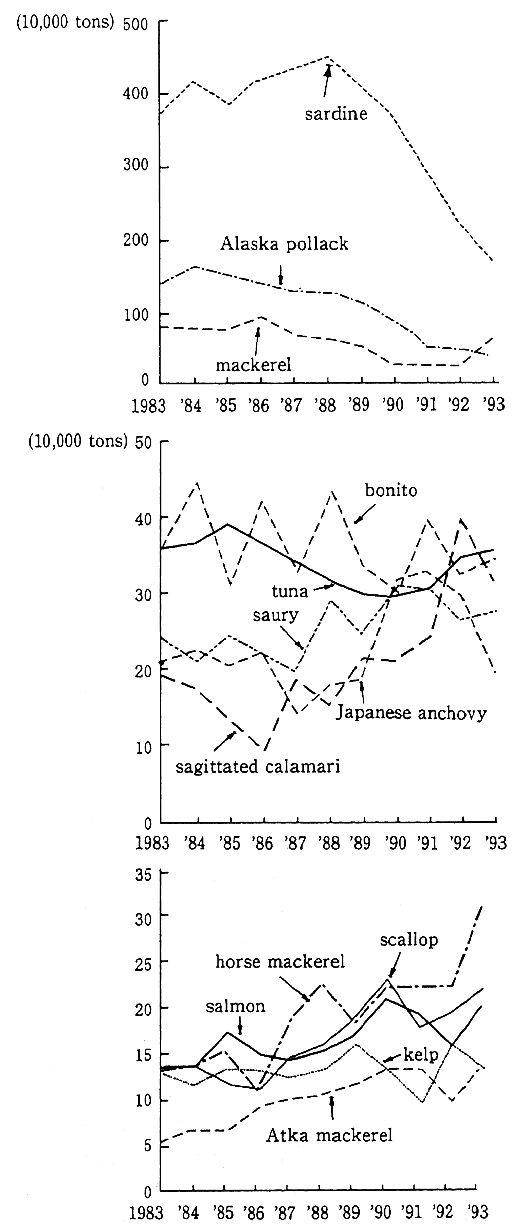
Fig. 5-6-4 Whale Catch in the Antarctic Ocean from the 1904-1905 Season through the 1980-1981 Season
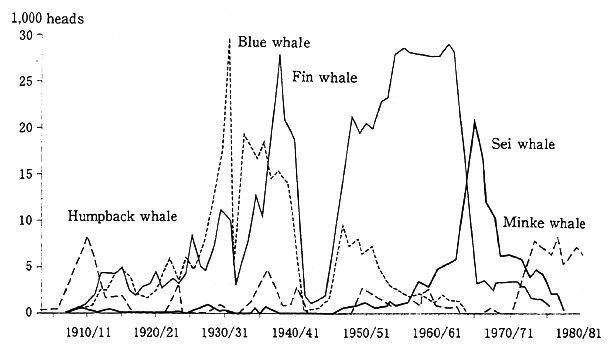
Source: "International Whaling Statistics" (provided by S. G. Brown)
(2) Hunting
Hunting is carried out by people as an occupation and as recreation, but it also plays a role as a measure for managing the appropriate number of birds and animals to correspond to the capacity of nature.
In Japan 29 species of birds, such as pheasant, crow, sparrow and duck and 18 species of animals, such as wild boar, raccoon dog and bear are stipulated as subject to hunting (in June 1994 Melanitta fusca, longtailed duck, Mergus serrator, squirrel and giant flying squirrel were deleted, and bulbul, gray starling, masked palm civet, raccoon and mink were added), but among the species that are subject to hunting, concerning species that require protection because the number living in an area has decreased, hunting has been restricted with the establishment of no hunting periods and areas (for example, bear). In 1992 the number of birds captured by hunting was about 2.94 million (rufous turtledove 29%, sparrow 26%) and the number of animals hunted was 330,000 (hare 52%, wild boar 19%, raccoon dog 11%). Further, the governors of prefectures and the Director-General of the Environment Agency were able to give permission for the capture of wild birds and animals in response to the objective of destroying harmful birds and animals, and in 1992 the birds and animals captured with the permission of governors were about 1.28 million birds and about 100,000 animals. When the number of these captured is added to the number of those hunted the total was about 4.22 million birds and about 430,000 animals.
Until 1976 the number of hunting licenses and the numbers captured by hunting continued to increase, but the total number of birds and animals captured in 1980, about 8.4 million, was the highest and afterwards it rapidly decreased. By 1992 it had declined to about 3.27 million. The hunting population, also, was about 530,000 in 1976, but in 1992 it had declined to about 260,000 and, moreover, the number that is aged is increasing considerably.
(3) International transactions
In advanced countries foreign birds and animals, especially tropical birds and animals, are imported for purposes, such as enjoyment. Due to the changes in the preferences for unusual animals and plants in the importing countries and the improvement of transportation technology, the amount of trade in wildlife from tropical regions to advanced countries has increased and has caused anxiety about its influence on the breeding and living conditions of wildlife. For this reason, in the Washington Convention, trade management is being carried out concerning international transactions, including the prohibition of international transactions in species that are in danger of becoming extinct, so that wild animals and plants will not become extinct due to trade activity (Table 5-6-5).
3. Pollution of Organisms
Among pollutants there are some whose existence has been confirmed spread across the diverse natural constituents of the environment, such as the air, water, soil and bottom sediment, and organisms also are exposed to the possibility of pollution.
Some types of organisms accumulate and concentrate specific hazardous heavy metals and chemical substances and show a high level of pollution compared to the air and water. Because their measured values can be regarded as indices of the accumulation conditions of pollution in a certain time period, they become significant data for comprehending the comprehensive result of various pollution countermeasures, the changes in the pollution levels and the behavior of substances in the environment that can be regarded as problems with respect to the ecological system and people's health.
Table 5-6-5 Wildlife and Trade in Their Products Reported according to the Washington Convention (1990)
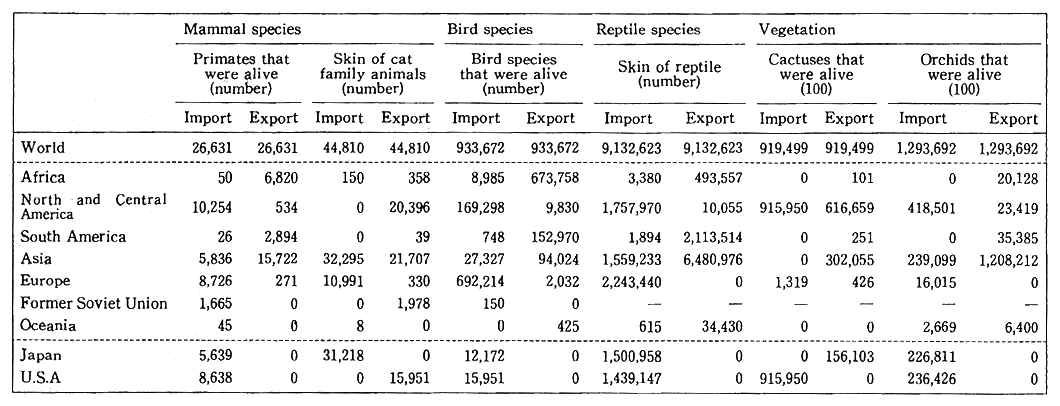
Note:-data unknown
Source: World Conservation Monitoring Center
Reference World Resources '94-'95
According to the chemical substance environmental survey related to fish in 1993 that had the object of detecting at an early stage the chemical substances left in the general environment and of compre-hending their levels of concentration, of the 18 substances that were the targets of the survey five substances were detected, but considering the detected concentrations, etc. they should not cause immediate problems. Further, according to the results of the biological monitoring survey that is conducted continuously, of the 24 substances that are the targets of the survey 21 substances have been detected. (Table 5-6-6).
Further, according to the 1993 results of the follow-up survey on the actual situation of pollution due to unintentionally formed chemical substances, the situation of the pollution of the general environment due to dioxins, at the present time, is that it cannot be regarded as having an effect on people's health, but even though the levels of concentration are low, dioxins have been detected and it is also necessary to follow-up and continue to watch the changes in pollution from now on (Table 5-6-7).
Section7. Contact with Nature
1. Emerging Needs
Recently, the increase in leisure time and the decrease in familiar natural surroundings in cities as well as the heightening of the con-sciousness of citizens with respect to the environment have heightened the need for coming into contact with nature and for deepening people's ties to the environment. As for coming into contact with nature it means the fundamental and, moreover, specific actions of people by which they receive the benefits that are brought about by the natural environment. For example, many modes can be thought of, such as going to a natural park, etc. and being impressed by the magnificence and beauty of nature, participating in the events of a nature observation group, etc. and deepening one's understanding of nature, and experiencing peace of mind when views such as water's edge areas and roadside trees come into sight in the city. But it can be said that it is indispensable for contacts with nature to cultivate the feeling that people should regard nature as important and to be for the purpose of restoring humanity.
Natural parks, in addition to protecting excellent natural land scape areas, promote their increased use and are for the purpose of contributing to relaxing citizens and to preserving their health. Recent-ly, in response to the increasing craving of citizens to become intimate with nature, there has been a trend towards an increase in the number of people visiting natural parks (Figure 5-7-1). When the number of people using all of the natural parks is looked at in the decade that began in 1975 it was, generally, unchanged, but since the beginning of the decade that began in 1985 it began to increase. In 1993 the number was 955.64 million people. When the number of annual users is looked at classified by type of park, the number of users of national parks was 389.92 million persons (in 1992 413.02 million persons), the number of users of quasi-national parks was 296.07 million persons (in 1992 320.28 million persons), the number of users of prefectural natural parks was 269.65 million persons (in 1992 286.04 million persons).
Table 5-6-6 Summary of the Results of the 1993 Biological Monitoring and Comparison with 1992
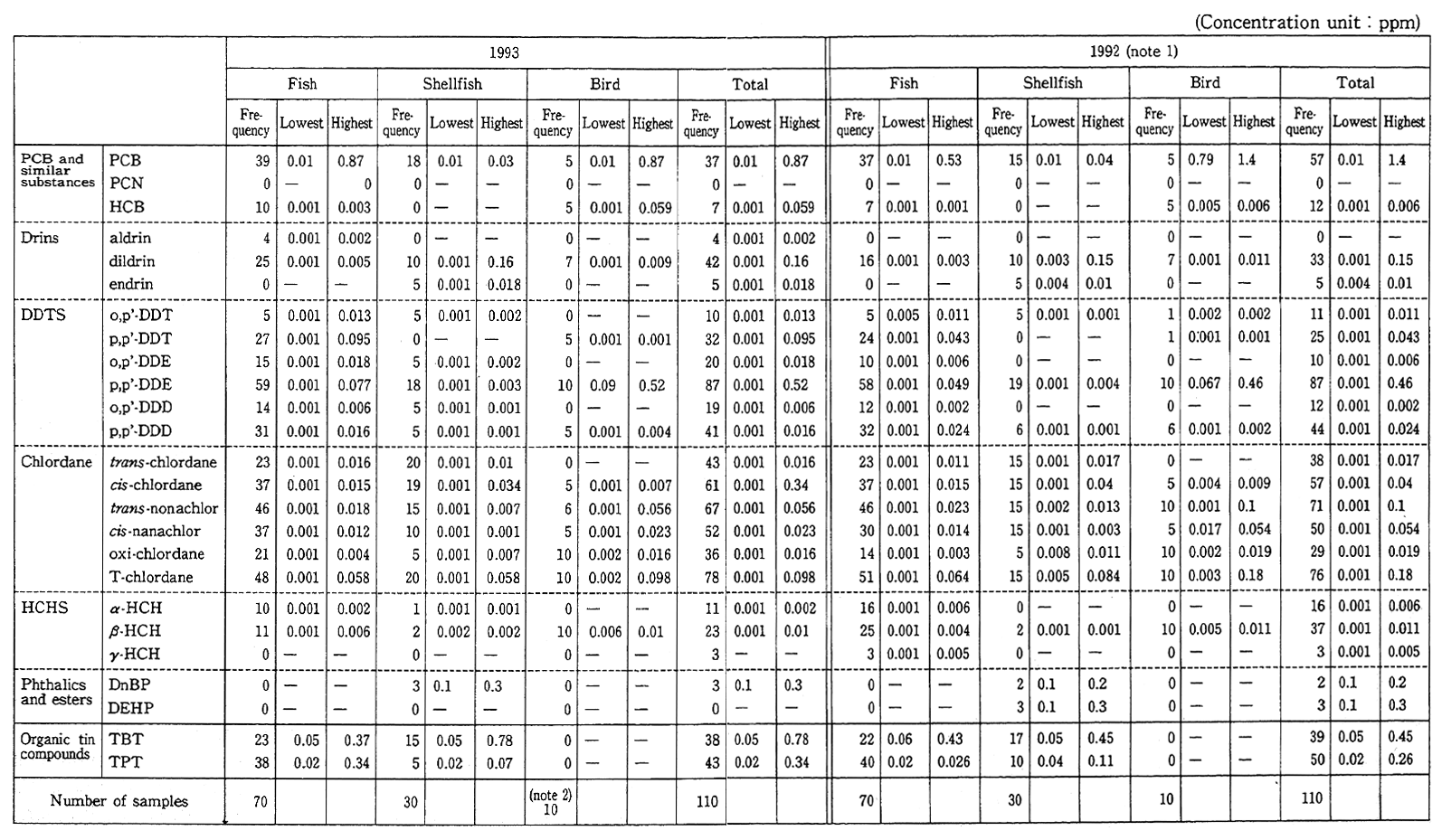
Notes: 1. The values of PCN, aidrin, endrin, phthalic acid esters are for 1991.
2 The number of bird samples of DEHP in 1993 was five.
According to a public opinion survey related to the use and protection of nature conducted in June 1991, as for the many purposes for going to a place where the environment was very natural, 35.5% said "in order to enjoy the beautiful natural landscape," 30.9% said "in order to enjoy mountain climbing and hiking," 28.0% said "in order to relax at a hot spring," and in response to the question, "Would you like the chances for coming into contact with nature to increase," 63.1% of the people responded, "I would like them to increas" (29.5% "I would like them to increase greatly").
Table 5-6-7 Results of Biological Monitoring for Dioxins (1993)
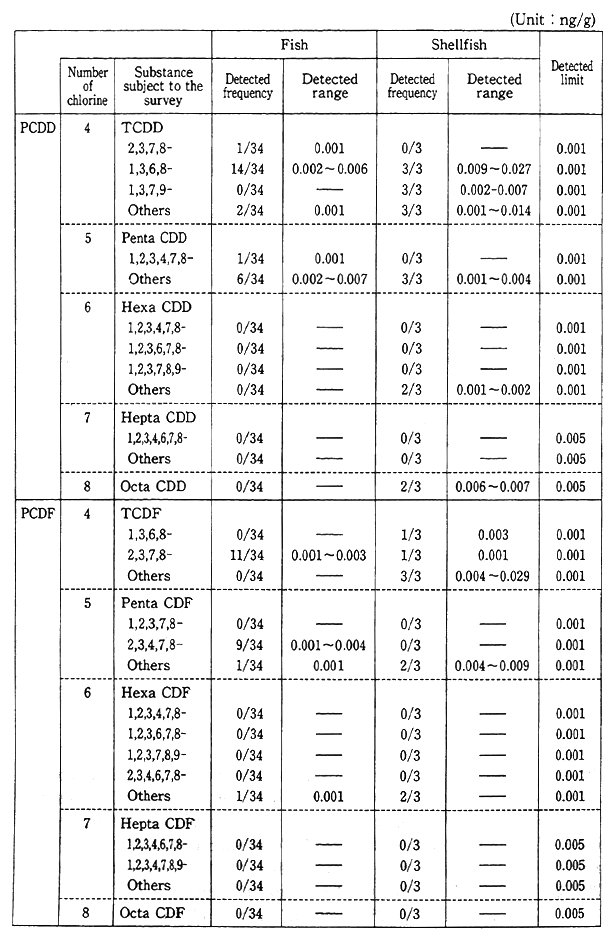
Fig. 5-6-1 Eagle Owl

Japanese Crested Ibis (designated as national endangered species)
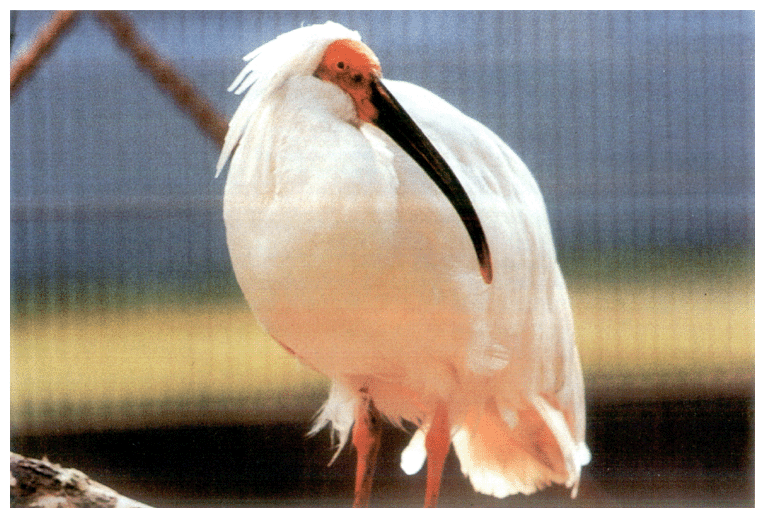
Fig. 5-7-1 Trends in Number of Visitors to Natural Parks
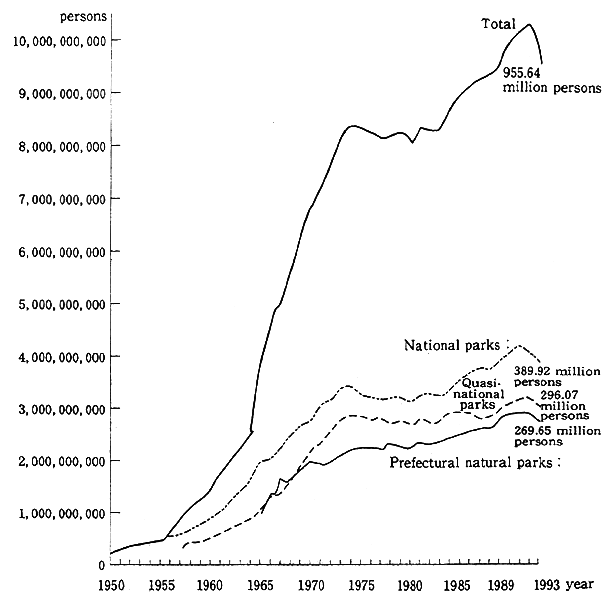
Note: Statistics on users began in 1957 for quasi-national parks and in 1965 for prefectural natural parks.
Further, in the February 1994 public opinion survey related to the future image of the country, 20.5% of all of the people mentioned "parks and green areas" as social facilities that they thought needed to be provided and expanded in residential areas. Goncerning the question "a place that is convenient to live in or a place that has a good natural environment" 41.8% of the total, and 55.9% of the people in large metropolitan areas, selected "in a place that has a better natural environment than the place where I live now," and, with respect to contact with nature, the consciousness of citizens can be expected to be raised more and more from now on.
2. Sites for Communicating with Nature
For the present society, in which most of the people have been born and raised in an artificial environment, such as a city, coming into contact with a world in which humanity can't do what it wants, such as in a primeval forest and plain, and experiencing nature as it is, is advantageous for recovering humanity. Further, the nature and scenery, such as the coast and mountains, which are made contact with at a travel destination, geographically and spiritually far from a residential area, also, impart a peace of mind that separates people from their daily lives. Natural parks and hot spring areas can be mentioned as places where citizens can come into contact with this kind of abundant nature.
Concerning natural parks, after the National Park Law was enacted in 1931, the Natural Parks Law was enacted in 1957 and a systematic system was established consisting of national parks, quasi-national parks and prefectural natural parks. At the end of 1994 the number of natural parks and their areas were 28 national parks consist-ing of 2,051,190 ha, 55 quasi-national parks consisting of 1,332,370 ha and 301 prefectural natural parks consisting of 1,943,046 ha. When the area is totaled it is 5,326,606 ha and makes up 14% of the national land area. When the changes in the areas are looked at, the area of national and quasi-national parks almost doubled from after the enactment of the Natural Parks Law until the last half of the decade that began in 1965, and since then it has remained unchanged until the present (Figure 5-7-2, Figure 5-7-3).
The necessity of ensuring places where the workings of nature can be understood through the experience of coming into contact with nature and safeguarding nature, such as water's edge environments or the greenery of village areas and the habitats of small animals in familiar regions, is being advocated as a countermeasure against the present in which familiar natural surroundings are rapidly being lost as a consequence of the progress of urbanization. The Environment Agency for a long time has promoted the provision of "villages where the living things of the home village can be come into contact with" (Figure 5-7-4), and in 1994 provided the "village where the living things of the Yukiiri village can be come into contact with" in the town of Chiyoda in Niihari-gun, Ibaraki Prefecture. Further, since 1994 in the three places of Tendo City in Yamagata Prefecture, Higashimatsuyama City in Saitama Prefecture and Kamagari Town, Aki-gun in Hiroshima Prefecture "home village nature path" operations have been started in order to create centers for the promotion of nature education and contact with nature, such as by the observation of nature through "walking" with one's own feet in familiar natural areas.
Fig. 5-7-2 Area Covered by Natural Parks
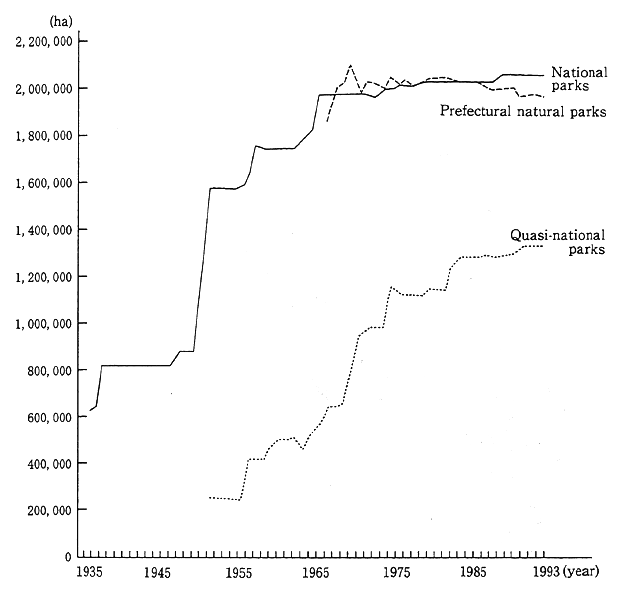
Source: Environment Agency
Hot springs for a long time have been familiar to citizens as places for the preservation of health and for rest and they also have been playing a great role from the standpoint of being places where people could come into contact with nature. In 1993 the number of people who used lodgings in the nation's hot spring areas reached about 139.73 million. Further, the Environment Agency, aiming to promote the public use of hot springs, is planning to designate hot spring areas that qualify due to their natural environment and superior efficacy for health preservation and for rest as hot spring health resorts and to promote them.
Fig. 5-7-3 Map of Locations of National Parks and Quasi-national Parks
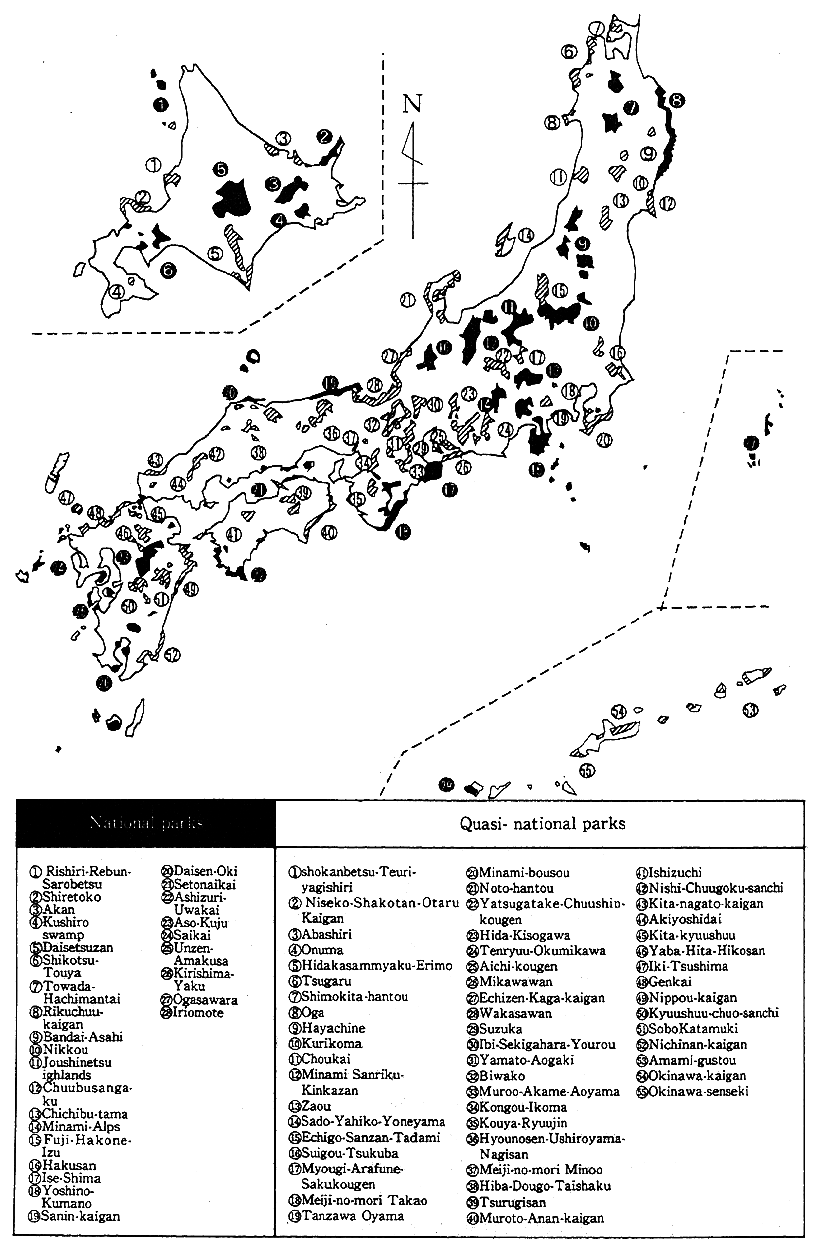
Fig. 5-7-4 Image Map of the Preparation Work at a Natural Environmental Conservation Activity Center
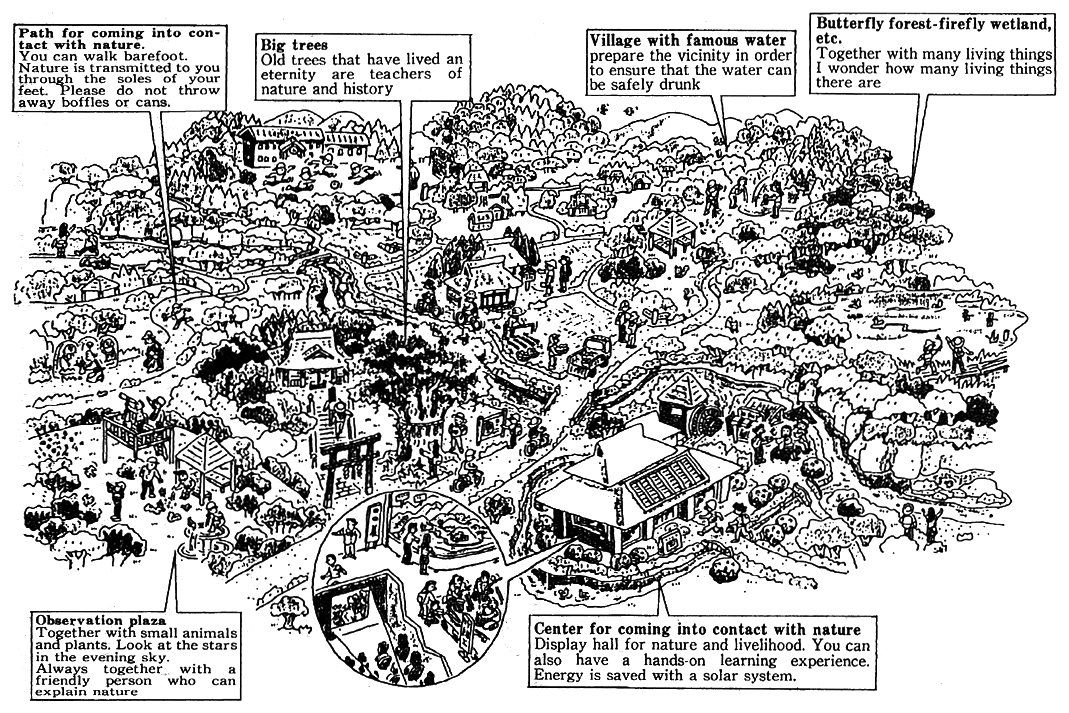
Besides this, the Environment Agency in 1985, striving for the rediscovery of the excellence of the clear water throughout Japan, in particular concerning spring water and flow water, has introduced to the general public 100 places from Rishiri Island in the north to Okiriawa Island in the south. The places in this selection of 100 famous waters were selected by such criteria as, conservation activity by the residents as well as hydrophilic character, the surrounding environment, water amount and water quality. And it is expected that concern for places where people can come into contact with abundant water, conservation of the water environment and good water resources will increase still more.
3. Events for the Purpose of Coming into Contact with Nature
Each year various functions and events are staged centering on 29 April "Green Day," on 5 June "Environment Day", and during the period of the Become Familiar with Nature Movement from 21 July to 20 August. For example, on Green Day in order to come into contact with nature, events that apyone can easily participate in, such as hiking and nature observation gatherings, are carried out in the natural parks of the entire nation, by national parks, wildlife offices, prefectural, municipal and related groups
Section8. The Status of Othor Aspects of the Environment
1. Heat Island Effect
In large metropolitan areas like that of the capital, a phenomenon completely different from that of the typical seven pollutions has appeared called the heat island phenomenon. In a city energy is consumed in a high density, in addition, because the surface of a city, for the most part, is covered with dry substances, such as concrete and asphalt, there is no lowering of the temperature by the evaporation of moisture and, because the heat radiated from the sun that has accumulated during the day is released at night, the situation becomes one in which the temperature in the evening does not go down. As a result, in a city, compared to the outskirts of a city, the temperature becomes high and because if an isotherm is drawn it looks just like a city has an "island" in the center, this phenomenon is called the heat island phenomenon.
This kind of phenomenon has already come to the point where it is able to be felt in everyday life in large cities, such as Tokyo. For example, when Tokyo's annual average temperature is looked at, as in Figure 5-8-1, during the past 120 years, from about 14 degrees in the decade of the 1870s, it has increased already two degrees, and the annual average humidity also has decreased from about 77% to about 63%. The heat island phenomenon can be regarded as one cause of this. Especially in the summer, the heat generated from air conditioning causes the temperature outside of rooms to increase still more, moreover, the increased temperature also produces the vicious cycle of increasing the energy demand.
In contrast to this, green areas have the function of adjusting the temperature because plants, when water evaporates from the surface of leaves, take the surrounding heat. Waterfront areas also, such as at rivers and water areas in cities, are said to have a mitigating effect on the heat island phenomenon. The various merits of natural areas, such as waterfront areas and green areas have attracted attention and the importance of natural areas in cities is increasing.
2. Light Pollution
The harm from artificial light comes from its influence, such as neon lights and street lights making the stars in the night sky difficult to see. Different from the typical seven pollutions like air pollution or water pollution, light does not effect people's health by floating in the environment and accumulating, and also it definitely does not bring about discomfort. According to the results during the summer of 1994 of the national continuous observation of starry nights (star watching network) conducted since 1988 by the Environment Agency, stars could be seen better in small and medium size cities as compared to very large and large cities. It goes without saying that artificial lighting is indis-pensable for guaranteeing safety, such as on roads and in sea routes, and in the maintenance of the functions of a city, but more light than necessary does not just waste energy, it cannot help but be connected to the loss of the starry night that since ancient times has been related to people's spiritual lives and, in turn, to the disappearance of a comfortable environment. Moreover, as it becomes more difficult to observe celestial objects the development of astronomy is hindered and influences, such as changes in the habitats of plants and animals due to excessive light in the evening, have caused anxiety.
Fig. 5-8-1
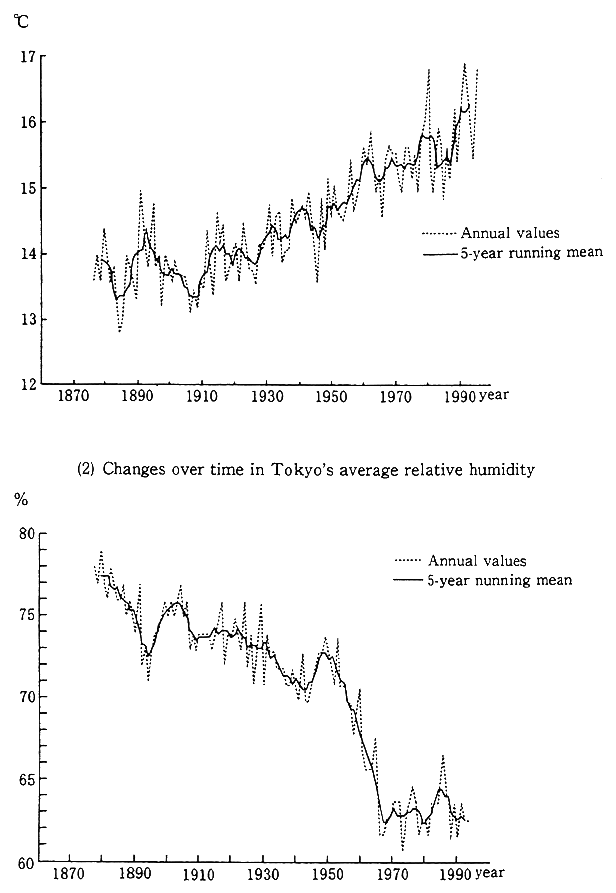
Source: Meteorological Agency
With respect to this kind of harm from artificial light, in Japan the town of Bisei in Oda-gun of Okayama Prefecture has taken the lead in the nation and introduced an ordinance to prevent harm from artificial light and has established various standards for outside lighting. Abroad, including the city of Tucson in the state of Arizona in the United States, in various cities ordinances to prevent harm from artificial light have been enacted.
3. Blocking of Sunlight, Air Circulation, Radio Wave Interference, Electromagnetic Waves, Hay Fever
When the fluctuations in the numbers of complaints, classified by complaints about things other than for the seven typical pollutions, are looked at, concerning the obstruction of sunlight, radio wave interfer-ence and air circulation damage (ventilation), there were 220 complaints about sunshine in 1993. It set a record in 1987 with 846 complaints, but the next year, in 1988, it decreased by half and since then it has repeatedly increased and decreased. There were 467 complaints for radio wave intefference in 1993 and in for the past three years it has been decreasing. There were two complaints of air circulation in 1993, and compared to the number of other complaints it is fluctuating at a comparatively low level (Figure 5-8-2).
Concerning the influence on health of electromagnetic waves, there have been many reports in abroad, but the relationship is still not clear. For this reason the Environment Agency in 1991 conducted the research related to the safety of the electromagnetic environment, and in 1994 again conducted research concerning the influence of electromagnetic waves on health.
Further, each year in the early spring from February to April many people suffer from cedar hay fever, but there are still many unclear points about the mechanism of its occurrence. For this reason, the Environment Agency is conducting research concerning the relation-ship of hay fever to air pollution substances, research related to the primary cause of the start of hay fever and research related to the way hay fever information should be provided.
Fig. 5-8-2 Trends in Complants About Pollution Other Than Seven Typical Pollutions
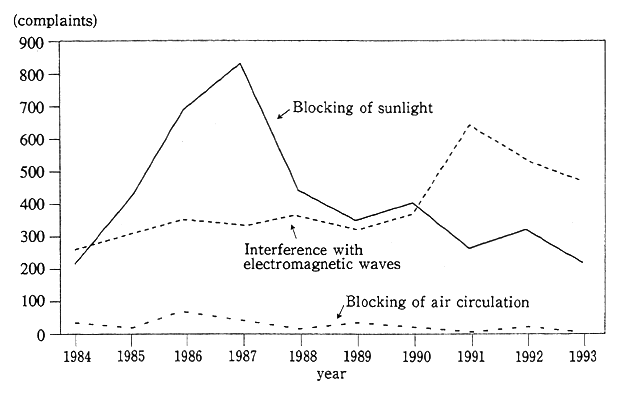
Source: Pollution Dispute Coordination Commission
Section9. The Status of Participation in Action related to Environmental Conservation
In solving today's environmental problems that originate in normal business activities and the activities of daily living it has become important for the nation, local public bodies, businesses, citizens and private groups to realize a society in which all of the constituencies participate in actions related to environmental conservation by means of voluntary, positive actions with a fair allotment of roles corresponding to their respective positions. For this reason, each constituency is acting in concert to cooperate in carrying out voluntary, positive measures, including environmental education, the promotion of environmental learning and the offering of environmental information.
1. The Status of the Action and Awareness of Business and Citizens concerning the Environment
(1) The action and awareness of citizens
The Basic Environment Plan is expected to deepen citizens' understanding of humanity's relationship with the environment to pro-mote voluntary and positive action to reduce the burden on the environ-ment originating in the activities of daily life and to make the nearby environment a better place.
In the Opinion Poll on Environmental Conservation by the Prime Minister's Office in February 1993, concerning environmental problems that people are concerned about now, most people, 64.4% of 3,754 persons, mentioned "problems originating in living, such as waste and household effluent." Next, 55.6% of the people mentioned "global envi-ronmental problems, such as global warming, ozone layer depletion and the decrease in the tropical forests." As for awareness concerning the influence of daily activities on the global environment, 89.3% of the people answered "daily activities exert an influence on the global environment," and it can be seen that today's environmental problems and their causes are accurately grasped. Further, in response to the question of what kinds of efforts and plans they carry out in their daily lives to conserve the environment, most people (61.9%) responded "don't wash "ternpura" oil and food remnants down the drain," next were, in order, "cooperate in separating garbage and in recycling old paper, milk cartons and empty cans" (57.7%), "throw out as little as possible" (47.0 %) (Table 5-9-1).
Further, according to the questionnaire survey, "Housewives and Environmental Problems" conducted by the Dai-Tokyo Fire and Marine Insurance Co., Ltd. in April 1993, in response to the question about what they associate with environmental problems the largest number, 361 of 1,000 persons, mentioned the waste problem and the high degree of concern about the waste problem among housewives can be seen.
(2) The actions and awareness of businesses
Businesses, in the Basic Environment Plan, are expected to voluntarily and positively promote a decrease in the burden on the environment, including the prevention of pollution, when engaged in various business activities, further, to take positive measures directed at the development of business activities related to environmental conservation (eco-business) and positive economic conservation activities that make the most of their abilities.
Table 5-9-1 Answer to a question what kind of plans or efforts you are making for environmental conservation.(multiple responses)

*1 Don't wash "tempura" oil and food remands down the drain.
*2 Cooperate in separating garbage and in recycling old paper, milk cartons and empty cans.
*3 In daily life I make an effort to save energy and water and to use energy saving products.
*4 When shopping I do not accept plastic bags.
Source: Prime Minister's Office, Public Opinion Survey on Environmental Conservation
According to the survey of business actions that were good for the environment carried out by the Environment Agency in 1994, of the 906 companies that responded, 45.7% of the companies had adopted management guidelines concerning the environment, and when the 3.2% of the companies which responded that they would enact them within this fiscal year are included, they comprise almost half of the number (Table 4-5-2). Further, concerning the content of the environmental management guidelines, of the 416 companies that responded that they had adopted management guidelines concerning the environment 91.3% of the companies mentioned "awareness of the present situation of environmental problems and the company's course of action (philosophy)" and 80.5% of the companies mentioned "to reduce as much as possible the burden on the environment that accompanies business activities."
When the content of the specific actions that are actually widely carried out at the working level at a company is looked at, "implement energy saving and resource saving in the office" was the most at 73.7%. Next, in order, were "thorough separation of old paper and waste and recycling" at 69.4% and "use recycled paper and recycled products" at 67.4%.
(3) The actions and awareness of private groups
Nonprofit private groups that carry out activities related to environmental conservation play a large role in environmental conservation in the Basic Environment Plan by carrying out activities systematically from the viewpoint of the public good, particularly, they are expected to be active in private international cooperation and in grass roots activities.
By means of a questionnaire survey related to the situation of Japan's environmental conservation groups carried out by the Environment Agency in 1992, it was found that of the 386 groups that responded to the questionnaire the percentage that did not have a full-time paid staff was 49.2%, the percentage of groups with from one to three persons was 16.6% and the percentage of groups with from four to nine persons was 14.2%. It was seen that there are many small-scale environmental conservation groups in the nation and, moreover, their operation is mostly left to volunteers. Further, according to the same survey it was seen that the percentage of regional type groups was large, with 233 groups, corresponding to 60%, being regional type groups that were active in one part of the country, of the remainder, with about 20% each, were national type groups that were active throughout the nation and international type groups that were active domestically and internationally. Concerning the form of the activities, when the groups are looked at as a whole, most were practical activities and developmental (educational) activities. When looked at individually, the percentage of practical activities in the regional type groups was high and in the national type groups and international type groups the percentage of develomental (educational) activities and research activities was high. Further, concerning the main areas of activity, in contrast to the inclination of the regional type groups towards nature conservation, water pollution and recycling in the regional environment, national type groups and international type groups carry out, comparatively, more diverse activities (Figure 5-9-1).
2. The Status of Specific Environmental Conservation Actions
(1) Voluntary environmental management
Businesses comprise a large part of economic activity. In order to reconsider the mass production, mass consumption and mass disposal type of socioeconomic activity the measures of businesses are important. Today, the burden on the environment caused by normal business activity is increasing. Voluntarily and positively promoting the reduction of the burden on the environment, including the prevention of pollution, when engaged in various business activities, has become necessary. For this reason, among businesses, movement to voluntarily and positively deal with environmental conservation has been increasing both inside and outside of the country. Against this background the method called "environmental management" has come about as one of business's important measures for voluntary environmental conservation.
Concerning this, in Japan, Keidanren (Japan Federation of Economic Organizations) in April 1991 announced the Keidanren Charter on the Global Environment that set forth the basic philosophy for Japan's businesses in dealing with the environmental problem. In October 1992 the Ministry of International Trade and Industry called upon the compe tent industry groups to prepare the Voluntary Plan Related to the Environment and in February 1993 the Environment Agency officially announced the Guideline on Corporate Activities Amiable to the Environment (refer to Chapter 4, Section 5).
Fig. 5-9-1
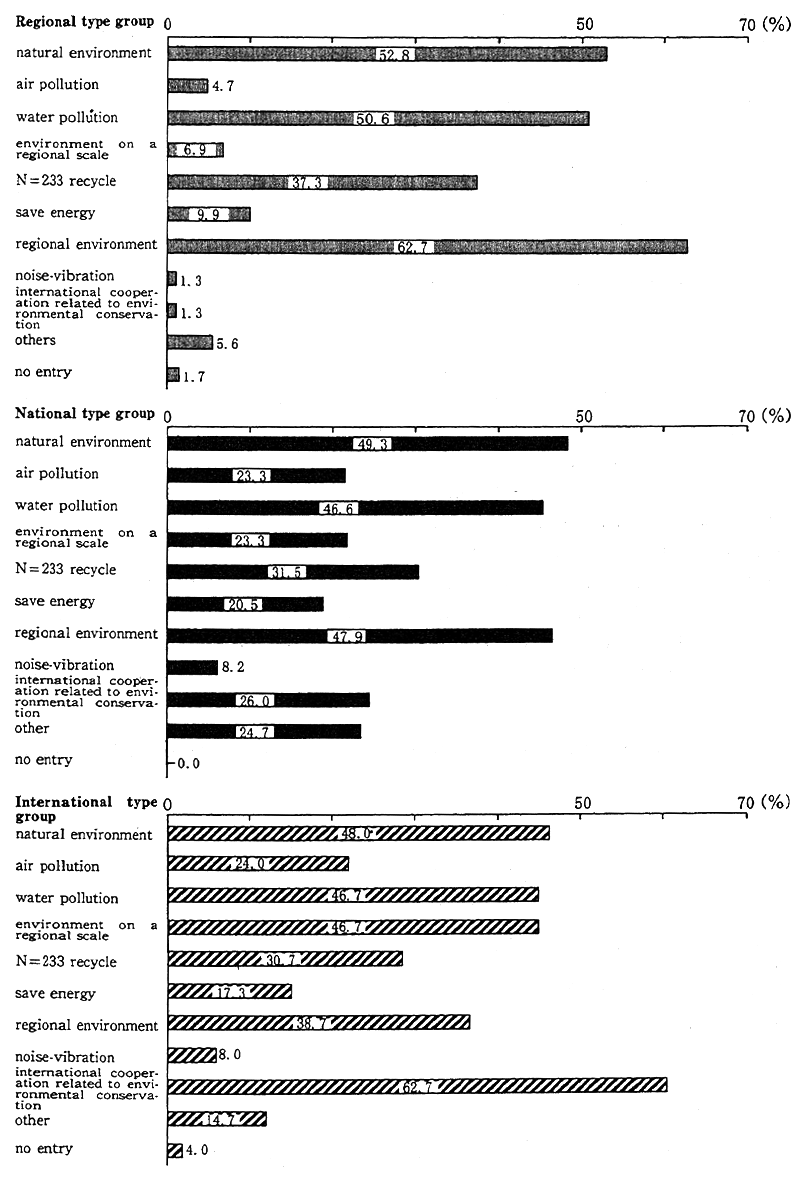
Source: Environment Agency, Questionnaire Survey concerning the Situation of Japan's Environmental Conservation Groups
Further, in the non-governmental organization ISO (International Organization for Standardization), concerning environmental manage-ment, since 1993 a committee of experts has been established and has been studying international standardization.
(2) Recommendation of desirable activity
The Eco-mark operation was started in February 1988 as one of the eco-labeling operations to recommend products that impose a small burden on the environment. The eco-mark promotion committee, com-posed of experts on environmental problems in various fields, deter-mines whether or not a product satisfies the requirements that take the environment into consideration that are stipulated by product type and the products that are approved are granted the eco-mark. The products that are subject to receiving the eco-mark, such as toilet paper that uses 100% old paper and a system that supplies hot water using solar heat, have increased year by year since the start of the operation and as of January 1995 there were 63 types and 2,322 brands (Figure 5-9-2). And among the products there are even some that have left the subject categories because the necessity for attaching the eco-mark has been lost since they have become common, like the stay-on-tab on a can.
Fig. 5-9-2 Trends in Types of Eco-mark Products and Approved Products

Source: Environment Agency
According to the Public Opinion Survey concerning Environmen-tal Conservation, conducted in February 1993, the percentages were that, 53.0% of 3,754 people responded that they knew of the eco-mark and 17.4% of the people responded that they had purchased an eco-mark product.
(3) Support of private group activity
The Global Environment Fund subsidizes many private groups in order to support the voluntary, positive environmental conservation activities of private groups. In 1993 it subsidized 104 cases with 406 million yen in response to requests from 254 cases for 2,119 billion yen, such as technical guidance for an acid deposition survey at Lake Baikal in Russia and a movement to decrease the amount of CO2 emitted and the energy of each household (Table 5-9-2).
Table 5-9-2 1993 Global Environment Fund Aid List-Aid Requested and Granted
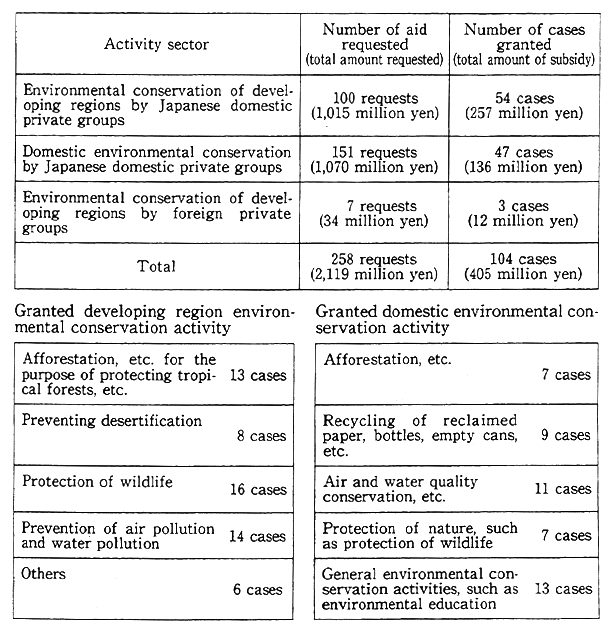
3. The Status of Environmental Education and Environmental Study
(1) Environmental study in school education
In school education the study of the environment is being conducted within the entire school education while aiming for mutual linkage among classes of each subject, morals and special activities. For example, various types of activities are progressing, such as study in which at each school the importance of the environmental problems of the nearby region is learned, such as in social studies investigating the nearby waste problem and presenting the results of the investigation, and in science class investigating the water quality in the rivers of the region. The Ministry of Education supports these activities and it is implementing a policy of preparing environmental education guidance materials that aim to promote environmental education still more.
Further, that the promotion of use of textbooks use recycled paper is significant because it is an opportunity to deepen the understanding of recycling among the children and students. The state of use of recycled paper for the back covers and frontispieces of textbooks for the 1995 term is 21.1% (Table 5-9-3).
(2) Environmental education and environmental study in social education and others
1) Provision of study centers
Voluntary and positive measures by all the constituencies that make up the economy and society are indispensable in order to solve today's environmental problems that originate in the activities of daily life and ordinary business activities. In order to promote these measures it is important that there is not a one-way offering of information and knowhow from the government to residents' groups, but that informa tion be provided corresponding to the concerns and needs of individual residents groups, or that support is given to the voluntary study and practical activities of residents' groups. As the main pillars of these support policies, the provision of environmental conservation activity promotion centers, such as environmental study centers and environmental information corners, are being established by municipalities. Up to now their provision has been implemented in about 20 municipalities at the prefectural level. In 1994 the provision of the Tokyo Metropolitan Study Center, etc. was carried out.
Table 5-9-3 Use of Recycled Paper in School Textbooks Used in 1995 (based on the new education guidelines)

Source: Ministry of Education
Further, as for coming into contact with nature, this is anything not be realized by being of the nature. In order to promote comfortable and safe use of nature the provision of facilities for these activities is indispensable. The present situation is that the expectations of citizens for the provision of public facilities, such as nature walking paths and campgrounds, are becoming higher. The provision of nature observation trails, parks, campgrounds, visitor centers and public toilets, etc. extending across a broad range from national parks and quasi-national parks with excellent natural environments to nearby natural areas, also among them, provision for "ecology campgrounds" and campgrounds that are facilities with concept of being environmentally-sound and enabling families to stay for a long time while being in contact with nature, began in 1993. In 1994 work started again at Haguro district of the Bandai-Asahi National Park, Darumayama district in the Fuji-Hakone-Izu National Park and Susa Bay district in the Kita-nagato-kaigan Quasi-national Park (Table 5-9-4).
Table 5-9-4 Summary of "Ecology Camp" (1994 new program)
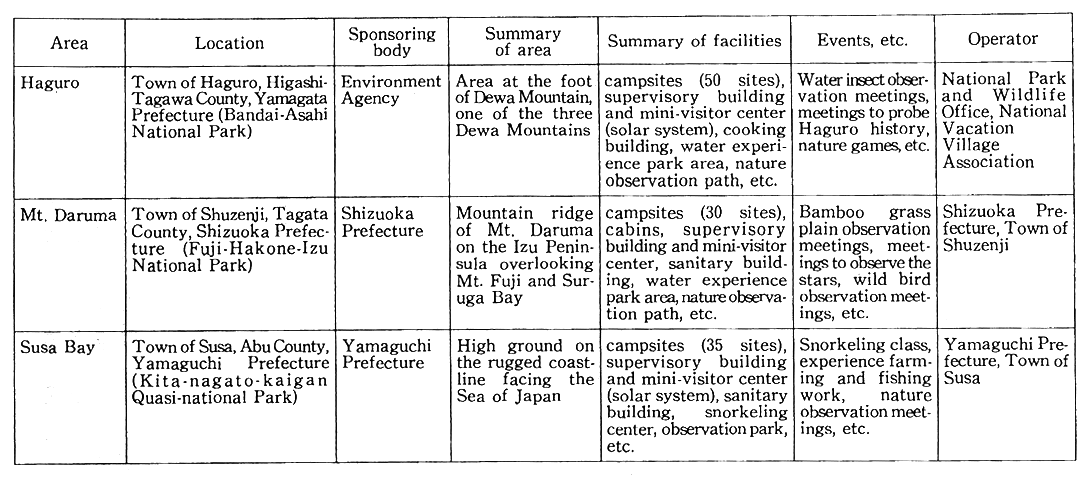
*Mini-visitor center is a rest house that functions to provide displays and information.
Sanitary building is hygiene facilities, with toilets and showers, etc.
2) Offer of study opportunities
Recently, study by personal experience has been implemented, such as nature observation meetings and starry night observations. The Environment Agency since 1988 has conducted the National Star Obser-vation Campaign (Star Watching Network) each summer and winter aiming to promote the awareness of environmental conservation of the air through the simple method of observing the night sky. Number of participants in summer 1994 was 9,948 persons of 408 participating groups (Table 5-9-5). Further, since 1989, based on the voluntary partici-pation of citizens, a national survey of aquatic life has been carried out to determine the quality of water by means of surveying aquatic life, such as May flies and river crabs. This survey is conducted by voluntary participation of residents, such as housewives' associations and elemen-tary, junior high and high school students. The number of participants increases year by year and in 1993 the number was the highest at 36,080 persons (Figure 5-9-3).
Table 5-9-5 Numbers of Participating Groups and People in National Star Observation Campaign (Star Watching Network)
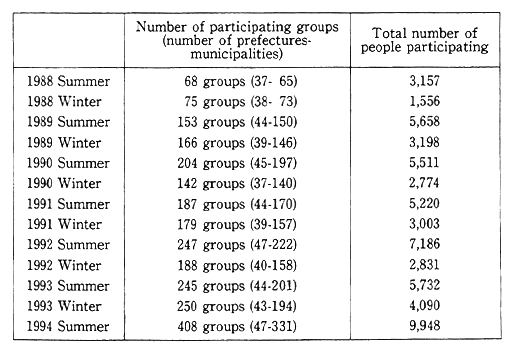
Source: Environment Agency
Fig. 5-9-3 Changes in Number of Participants and Number of Participating Groups in the National Aquatic Life Survey

3) Securing and educating personnel
In order to effectively promote environmental education, environmental study, environmental conservation activity and coming into contact with nature it is necessary to secure and educate the personnel that perform the guiding roles. Further, it is indispensable that volimtary and positive measures to conserve the environment by citizens are promoted, but in order to support these measures, in some municipal-ities the securing and educating personnel, such as "environmental conservation advisors," to contribute to the promotion of environmental conservation activities is being carried out. National park management officials (rangers) that are the personnel of the Environment Agency are stationed in 28 national parks nationwide. In addition to the work related to the managing of the park area they carry out the planning and implementation of activities to interpret nature to the users of the parks. Besides this, many volunteers are active in the national parks and quasi-national parks. At present there are about 3,000 national park advisors that provide information and guidance to users of the parks so that the national parks and quasi-national parks will be properly used and protected. Further, at present there are about 1,500 persons active as park volunteers that, respectively, assist the work of beautification and cleanup and of interpreting the nature of the national parks.
4. Offering of Information
Offering to people information related to measures for environmental conservation, the burdens on the environment due to individual social activities and environmental conditions has important significance for promoting environmental study and environmental education and for developing environmental conservation awareness. The Environment Agency each year prepares an annual report (Quality of the Environment in Japan) concerning the present state of the environment, but besides this, based on the Quality of the Environment in Japan, it offers information concerning the environment in various media, such as preparing the Quality of the Envfronment in Japan as seen in charts and graphs (in both Japanese and English) as a comic book (in both Japanese and English), in form of casset or CD-ROM. Further, aiming to construct an environmental information offering system to help promote local environmental administration and private environmental conservation activities, the design of the system, the development of the basic functions and the gathering and organization of information source information have been carried out and the start of operation in 1995 is aimed for.
According to the survey concerning the state of the provision of environmental information conducted in December 1994 targeting 47 prefectures and 12 ordinance designated cities (hereafter referred to as "59 local governments"), of the 59 local governments 58 self-governing communities had systems to offer environmental information (57 in 1993) and the number of systems possessed by these local governments was totaled 139 (130 in 1993). When those to whom the data was offered is looked at, 33.8% was offered to residents and businesses and there-is an increasing trend, but, as before, use only within government com prised the majority of the use (Figure 5-9-4).
Fig. 5-9.4 User of Environmental Data
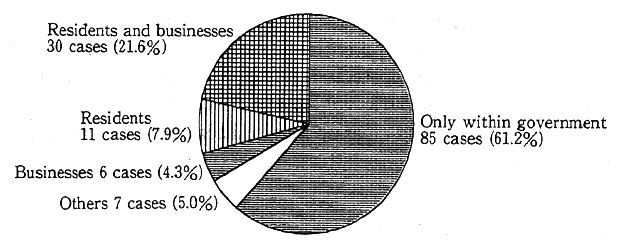
Source: Environment Agency
Further, with the Internet, whose network has been rapidly spreading recently, it is possible to use the environment related report offering service of the Environmental Protection Agency of the United States and to obtain the environmental information of the United Nations organizations, such as the publicized information material of the World Meteorological Organization.